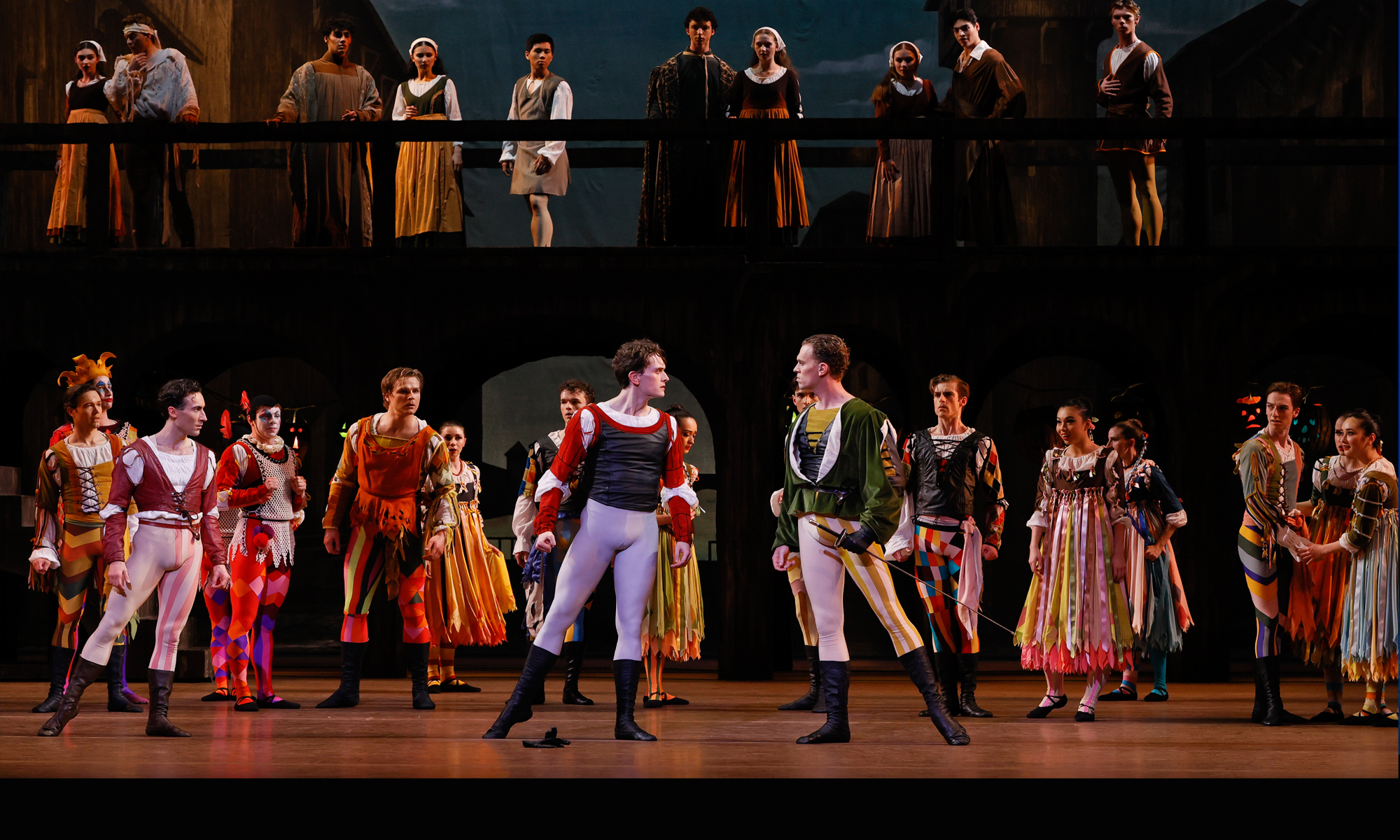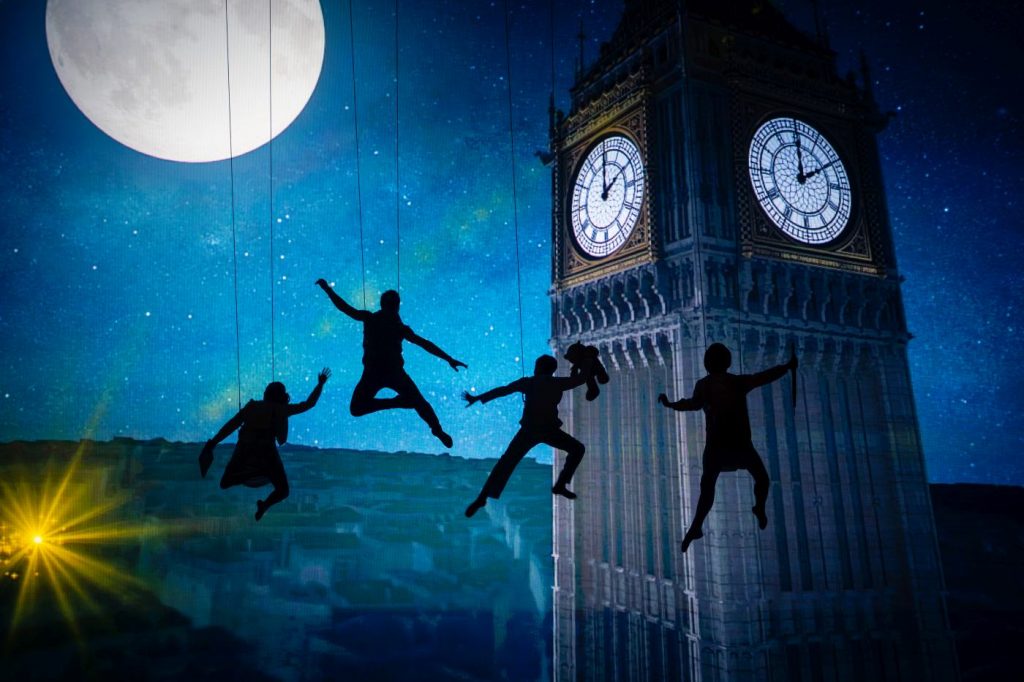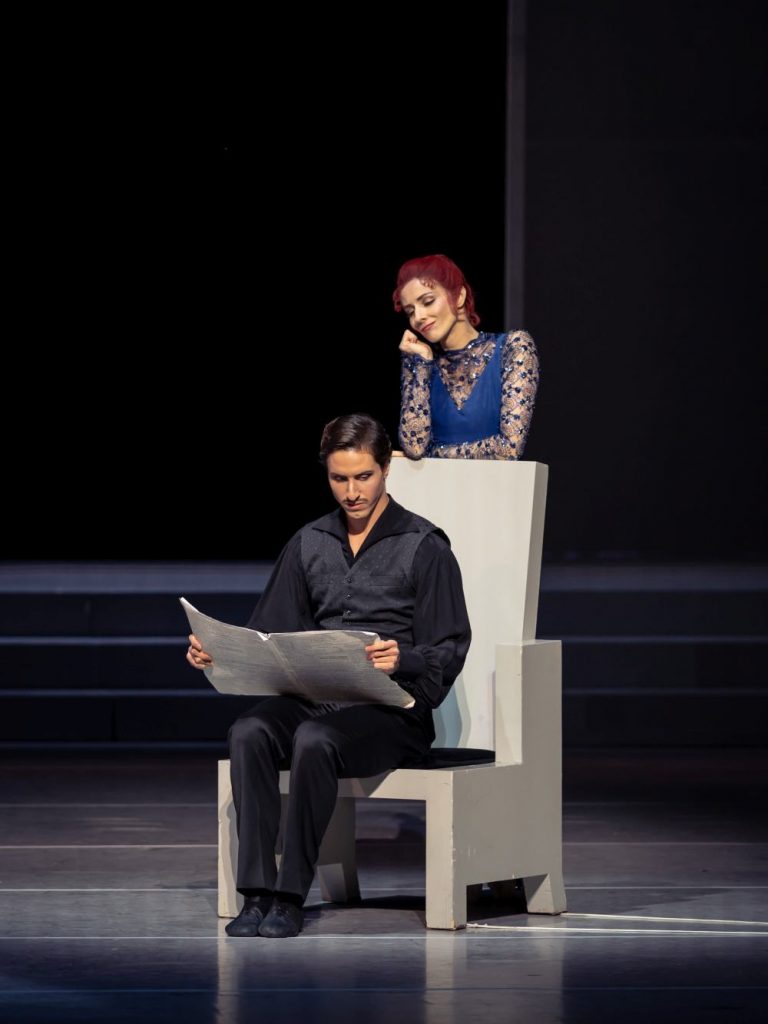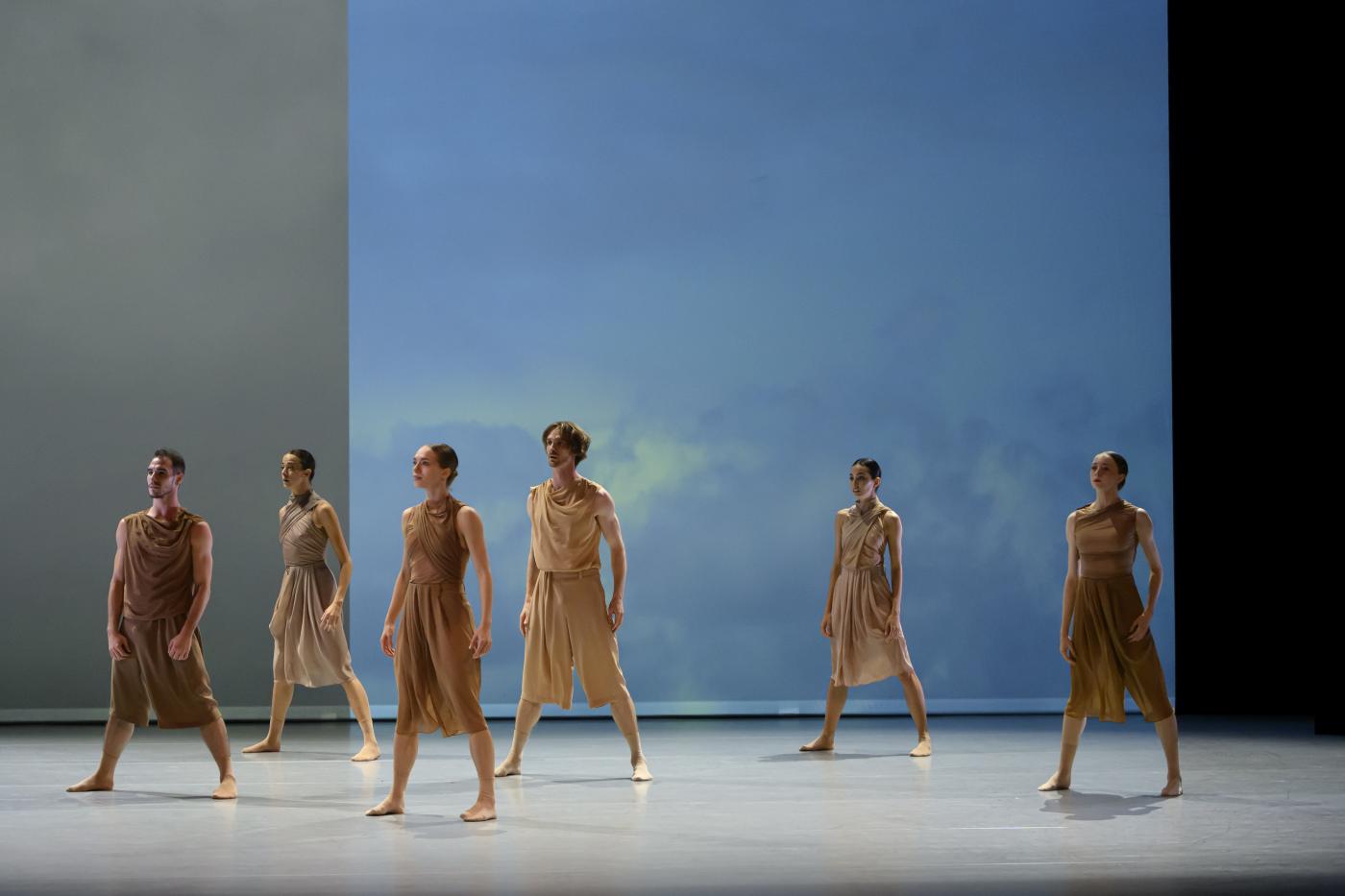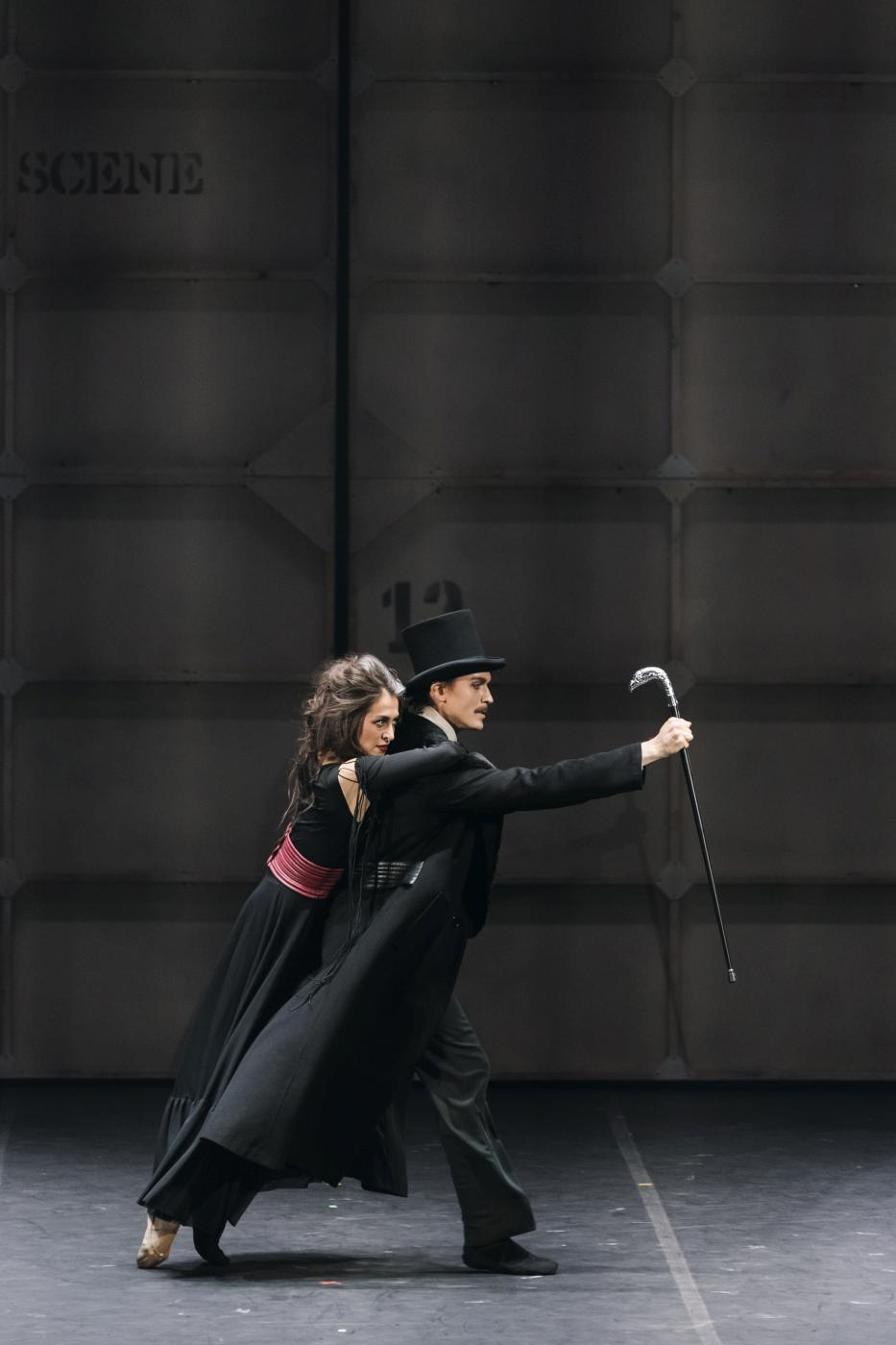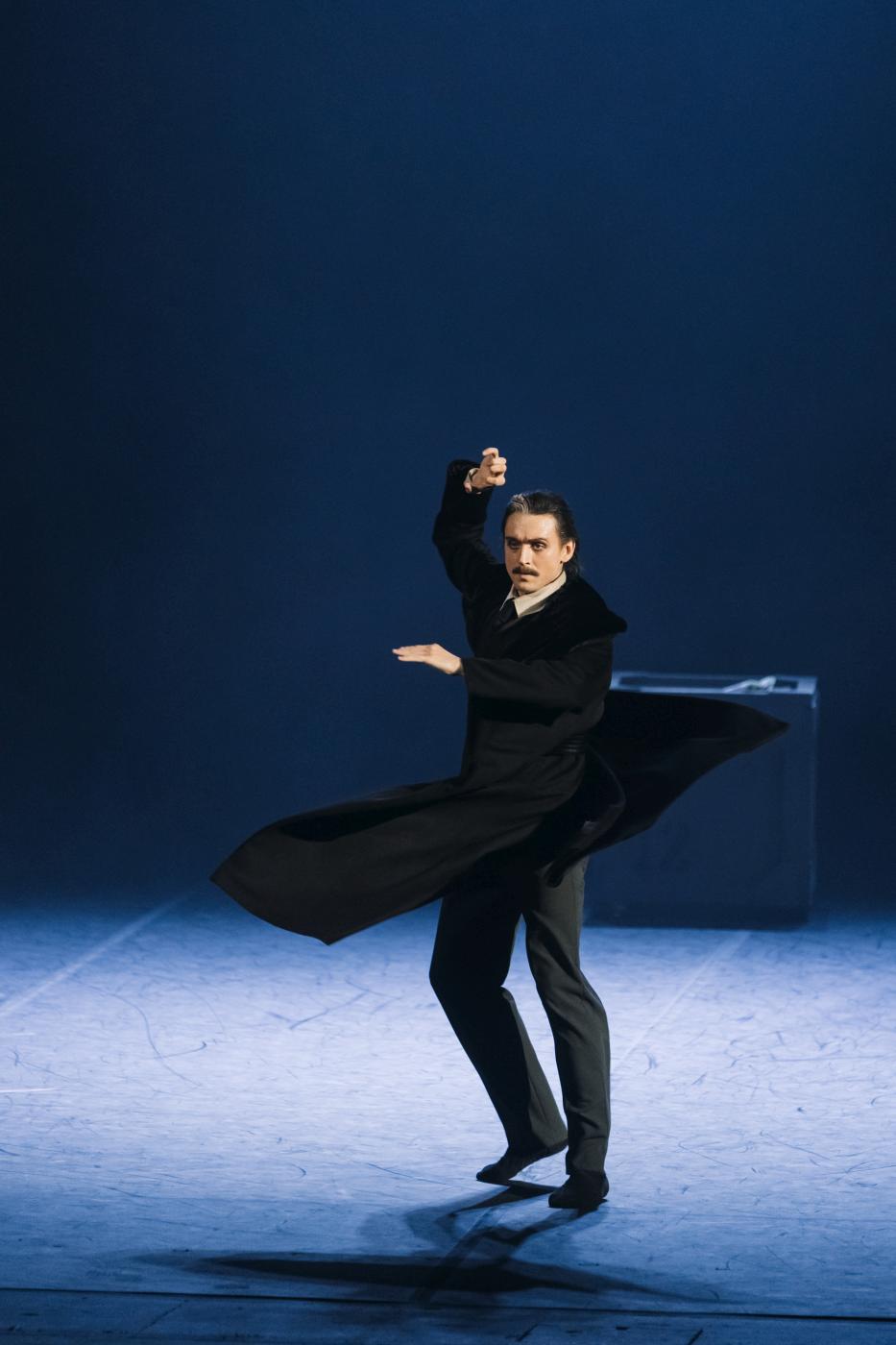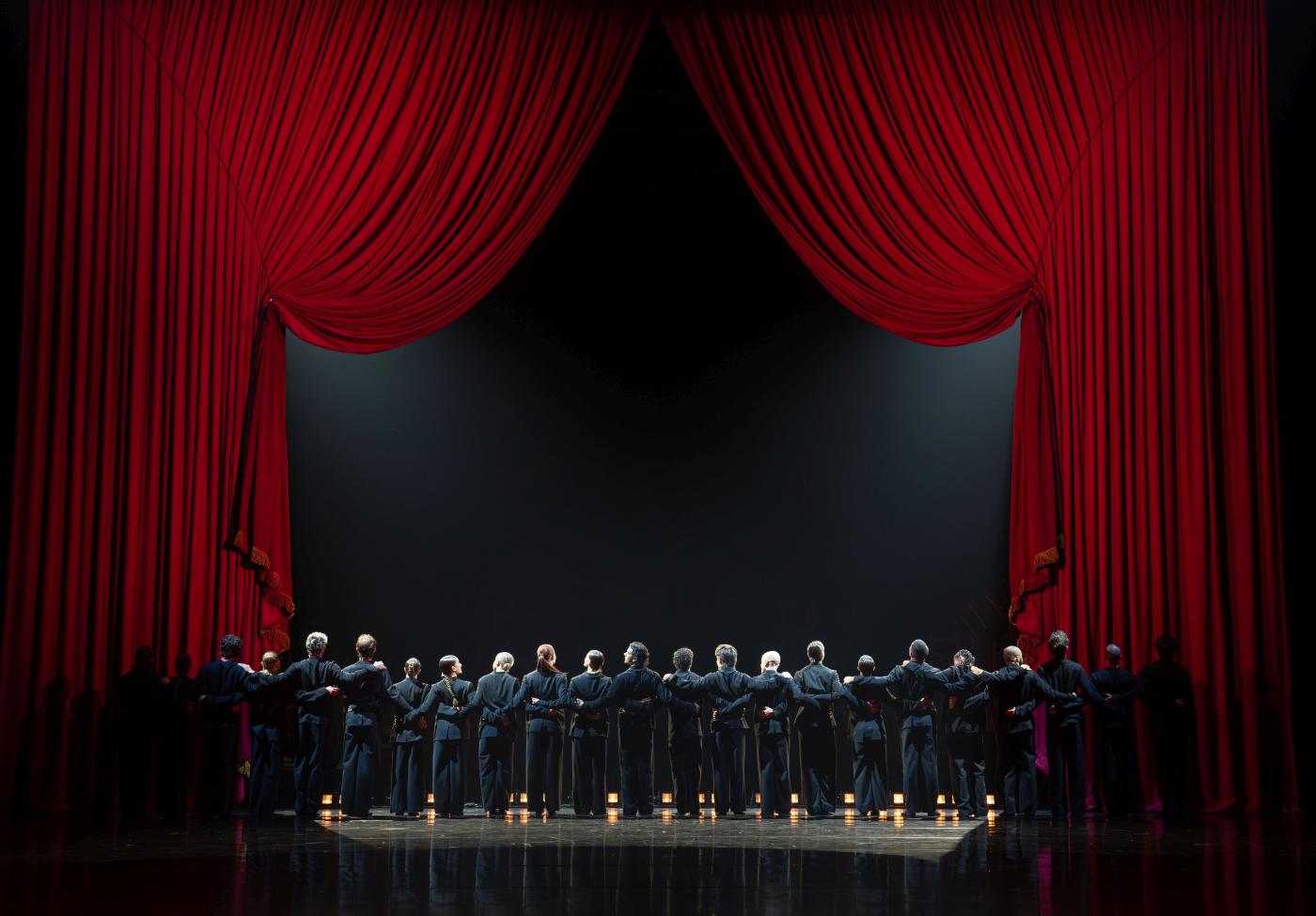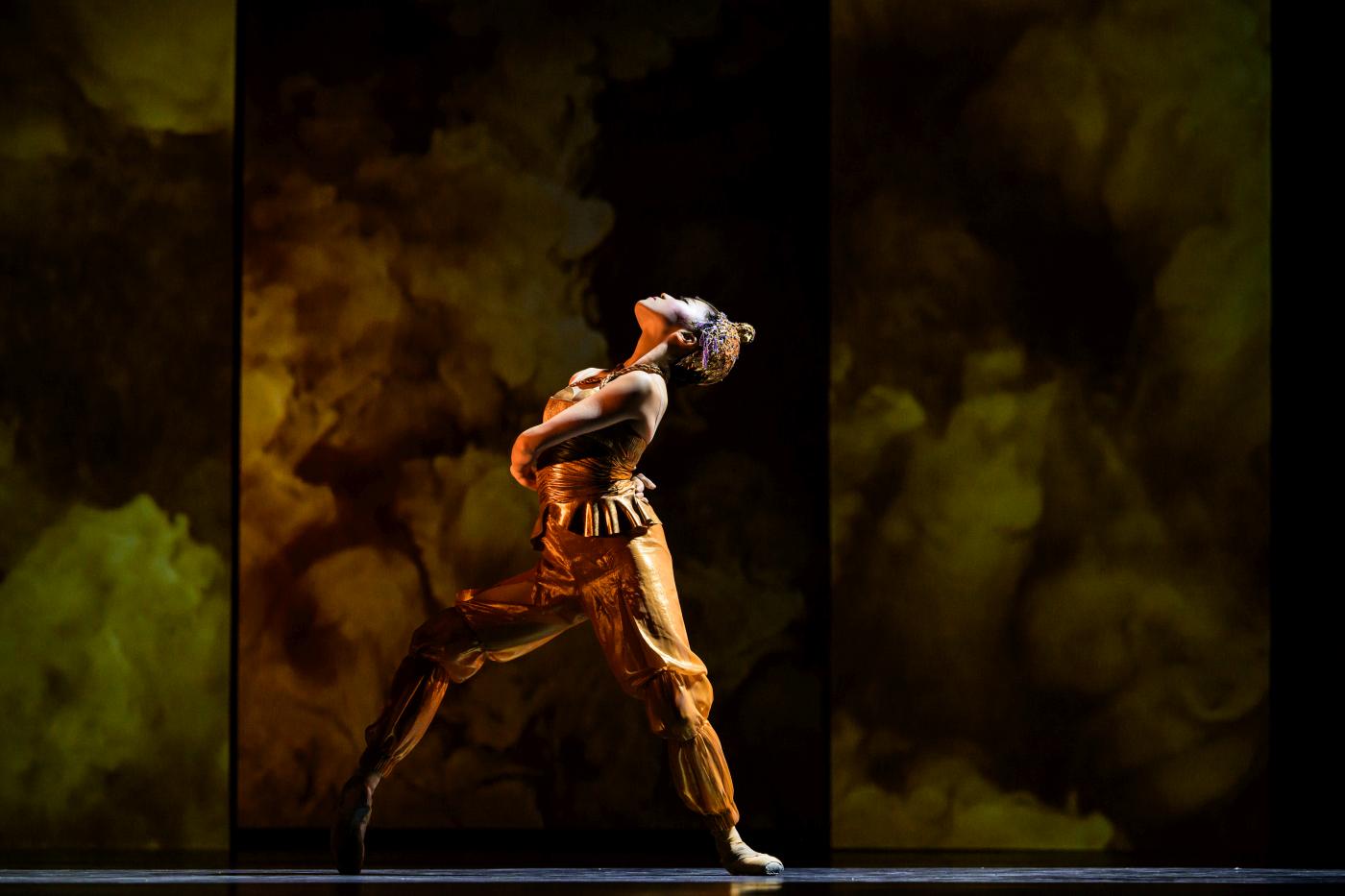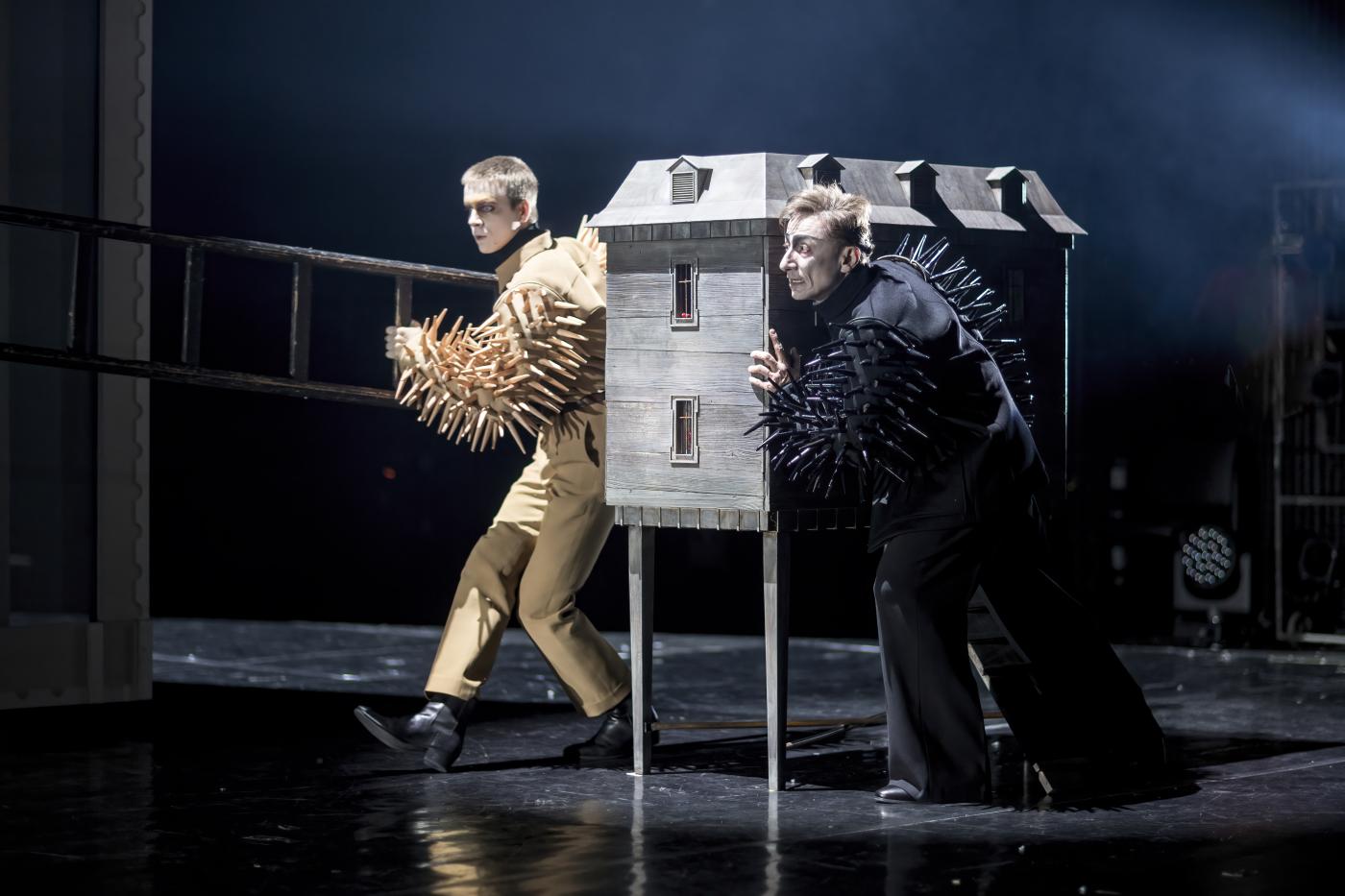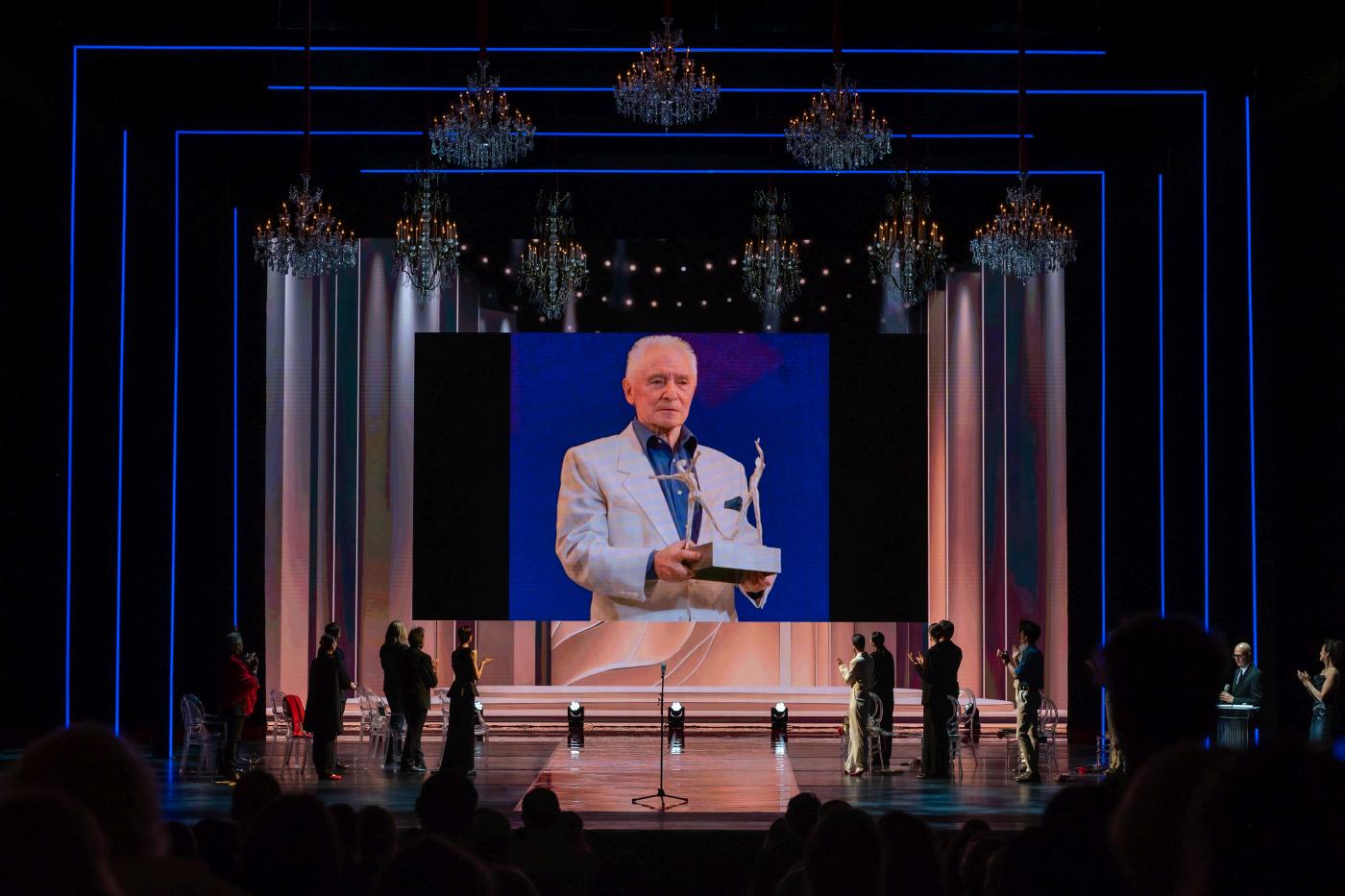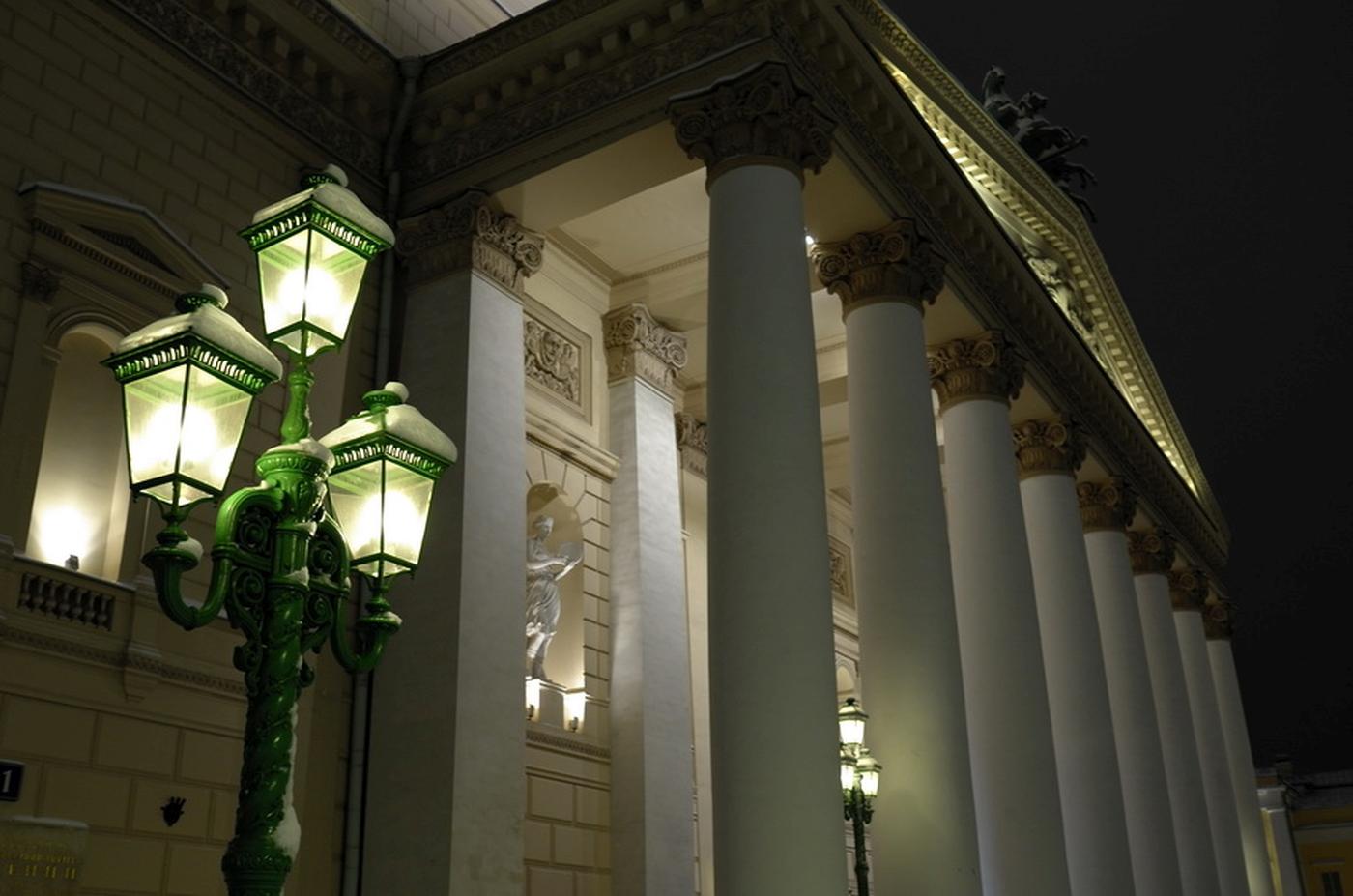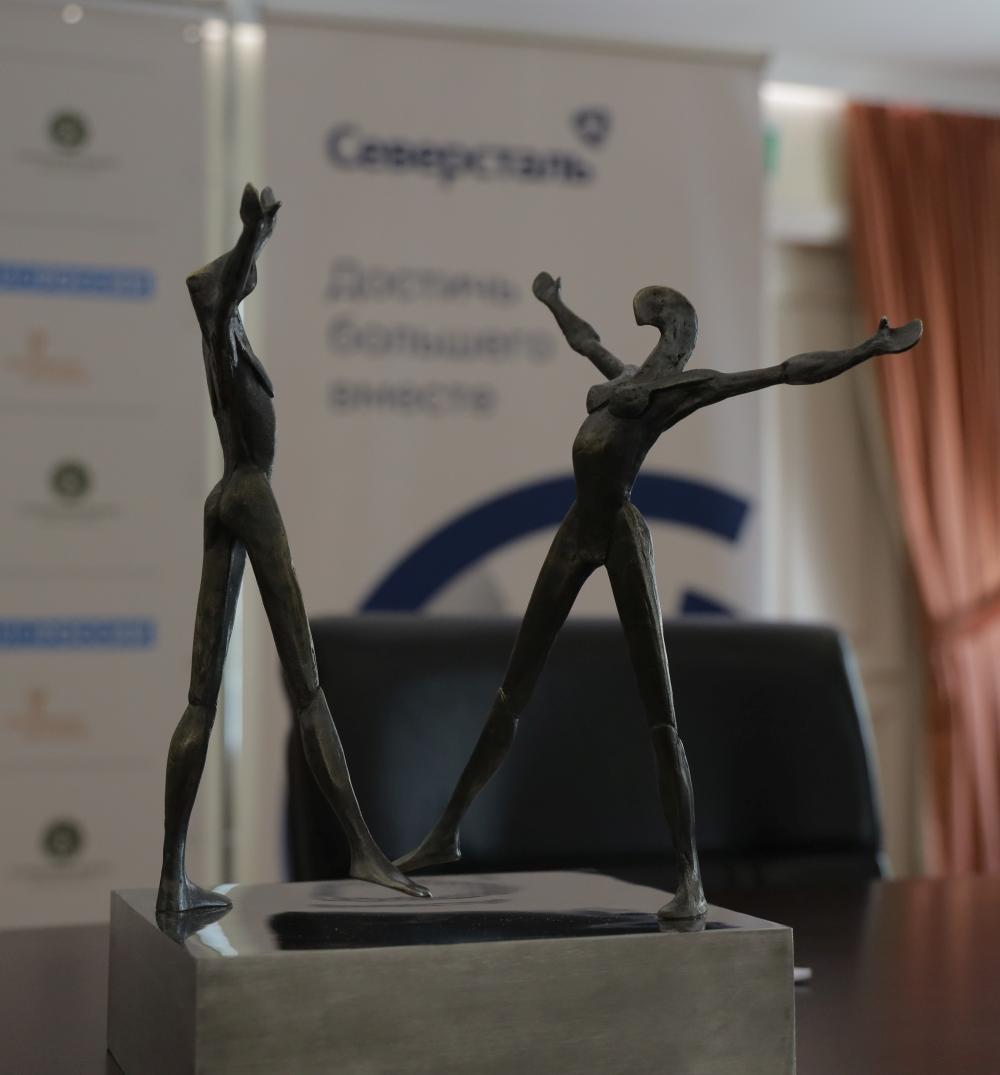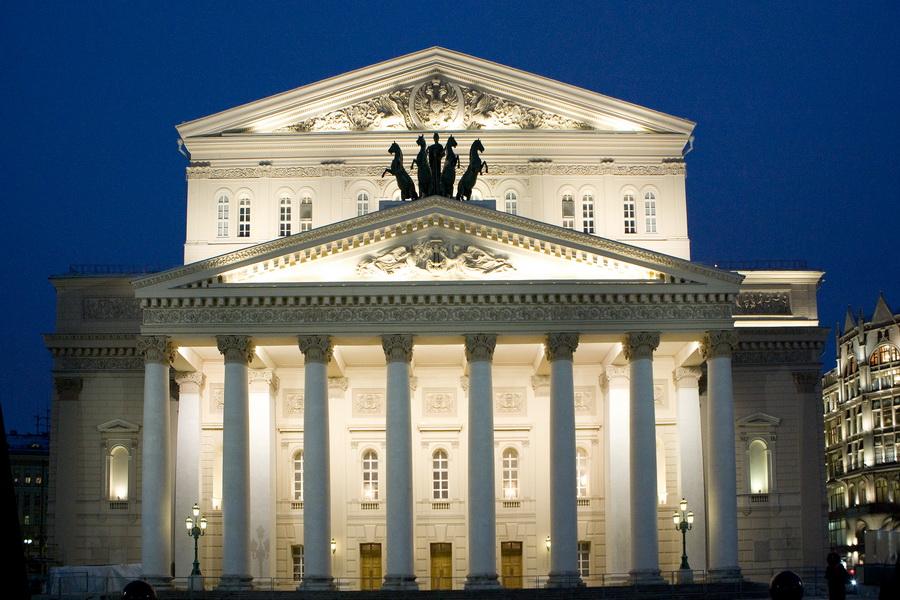“Two Annas”
MuzArts
Tovstonogov Bolshoi Drama Theatre
St. Petersburg, Russia
December 2025 (video)
by Ilona Landgraf
Copyright © 2025 by Ilona Landgraf
 The production company MuzArts, founded in 2014 to showcase the Bolshoi Ballet’s prima ballerina, Svetlana Zakharova, has grown into a vital force of Russia’s ballet scene. Their recent production, Two Annas, was supported by the Diaghilev P.S. International Festival of Arts, a prominent, intercultural, cross-genre event that has been held in St. Petersburg since 2009. Two Annas premiered at St. Petersburg’s Tovstonogov Bolshoi Drama Theatre this February and received its Moscow premiere at the Maly Theatre. Thanks to the MuzArts’s director, Yuri Baranov, I was able to watch a video of the production.
The production company MuzArts, founded in 2014 to showcase the Bolshoi Ballet’s prima ballerina, Svetlana Zakharova, has grown into a vital force of Russia’s ballet scene. Their recent production, Two Annas, was supported by the Diaghilev P.S. International Festival of Arts, a prominent, intercultural, cross-genre event that has been held in St. Petersburg since 2009. Two Annas premiered at St. Petersburg’s Tovstonogov Bolshoi Drama Theatre this February and received its Moscow premiere at the Maly Theatre. Thanks to the MuzArts’s director, Yuri Baranov, I was able to watch a video of the production.
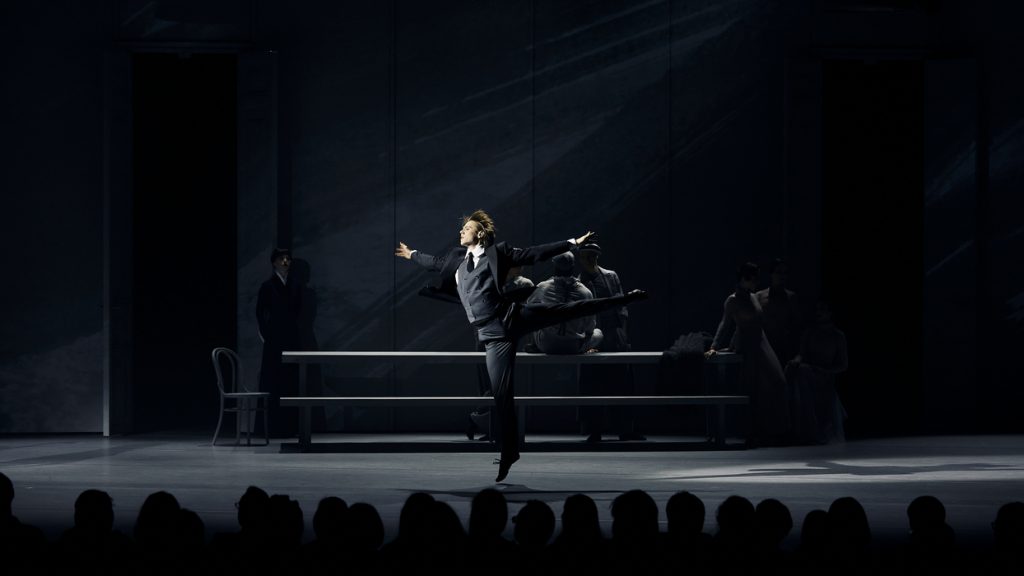
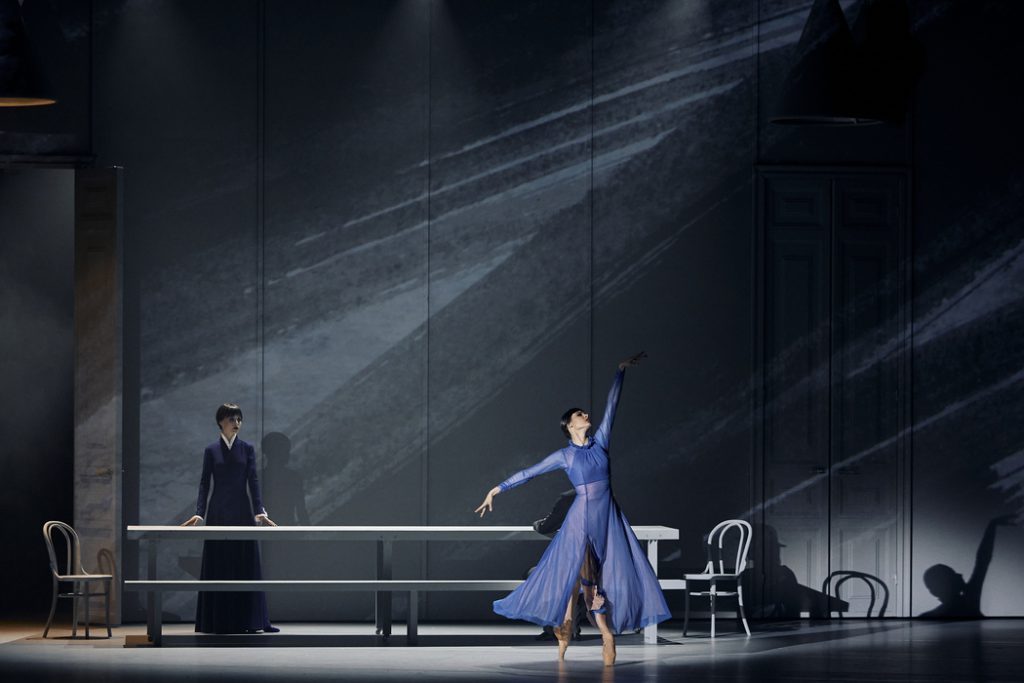 The title’s Annas are the Russian and Soviet poetess, Anna Akhmatova (1889-1966), and Anna Pavlova (1881-1931), both symbols of the Silver Age. I can’t say for certain, but presumably they never met in person, as Two Annas is a double bill of two separate ballets: Akhmatova by Yuri Possokhov and Pavlova by Pavel Glukhov. The artistic team included set designer Maria Tregubova, costume designer Svetlana Tegin, and lighting expert Ivan Vinogradov.
The title’s Annas are the Russian and Soviet poetess, Anna Akhmatova (1889-1966), and Anna Pavlova (1881-1931), both symbols of the Silver Age. I can’t say for certain, but presumably they never met in person, as Two Annas is a double bill of two separate ballets: Akhmatova by Yuri Possokhov and Pavlova by Pavel Glukhov. The artistic team included set designer Maria Tregubova, costume designer Svetlana Tegin, and lighting expert Ivan Vinogradov.
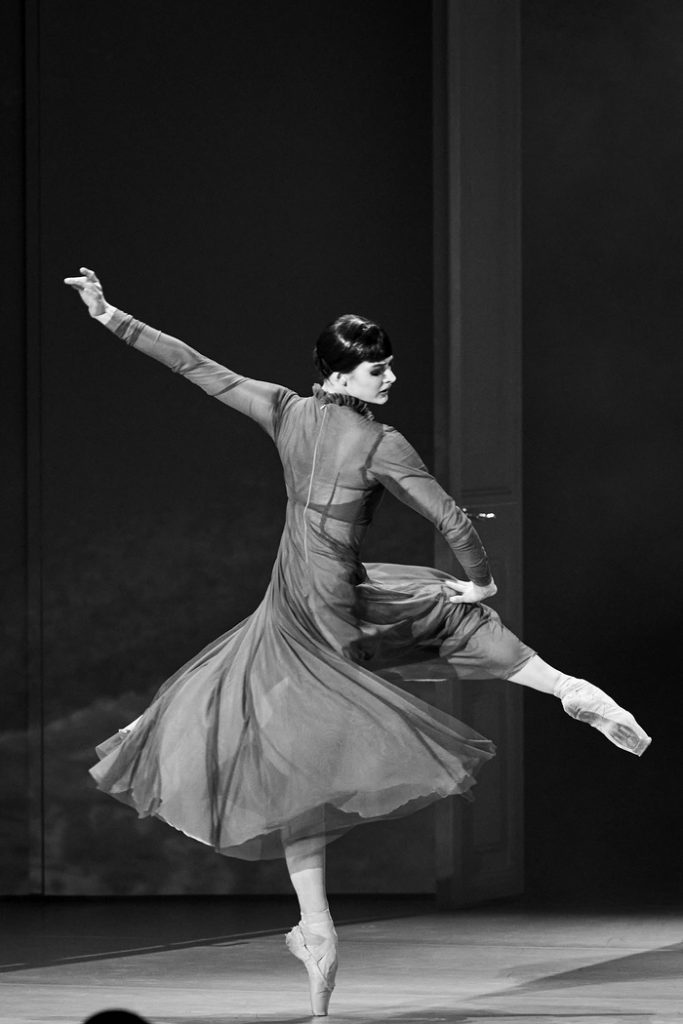
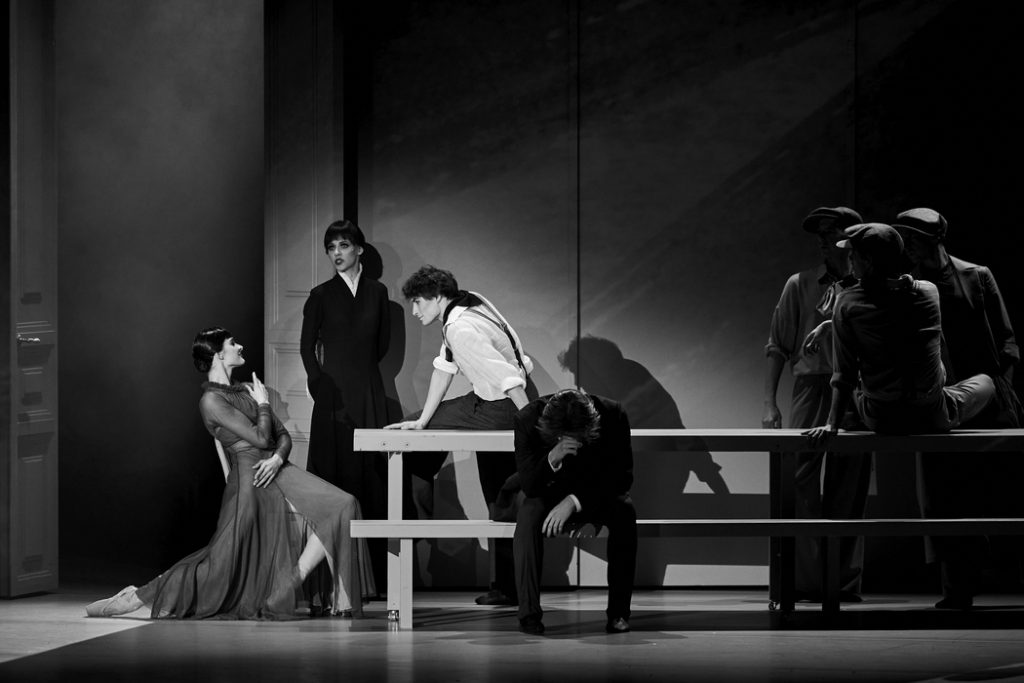 Felix Mikhailov wrote the libretto and acted as the production’s director. Music by César Franck accompanied Akhmatova; Ilya Demutsky composed the score for Pavlova. Both were played by the Opensound Orchestra at whose piano sat Andrei Korobeinikov. Except for Ildar Gainutdinov, who performed with Pavlova, all dancers are on the Bolshoi Ballet’s roster.
Felix Mikhailov wrote the libretto and acted as the production’s director. Music by César Franck accompanied Akhmatova; Ilya Demutsky composed the score for Pavlova. Both were played by the Opensound Orchestra at whose piano sat Andrei Korobeinikov. Except for Ildar Gainutdinov, who performed with Pavlova, all dancers are on the Bolshoi Ballet’s roster.
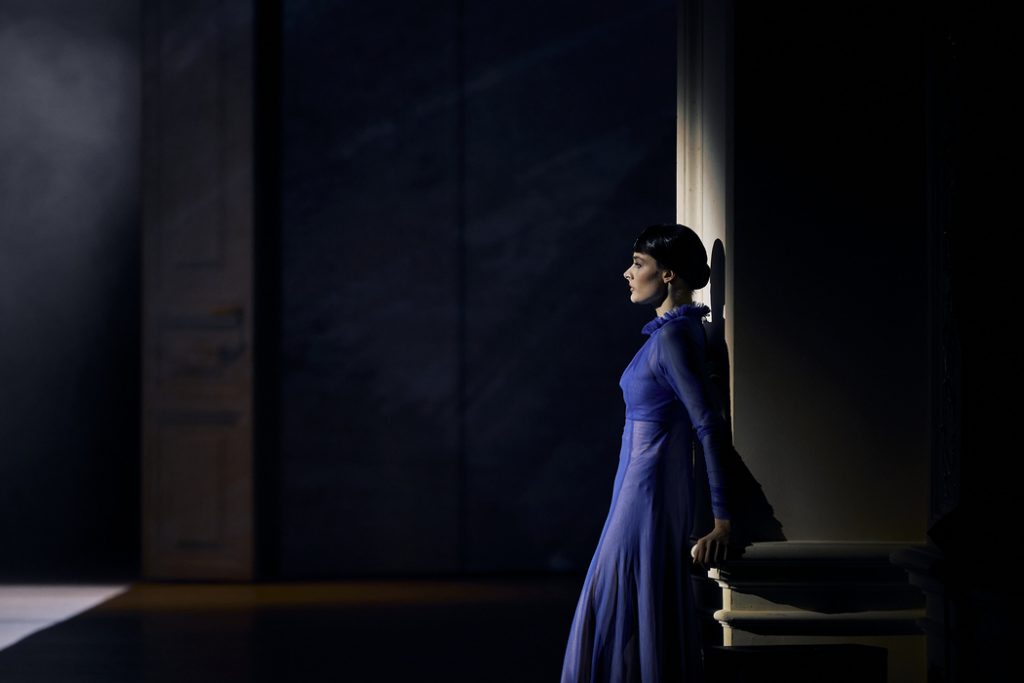 Akhmatova features the love triangle between Akhmatova, her husband, Nikolai Gumilev, and the Italian painter and sculptor, Amedeo Modigliani, whom she met in 1910 on her honeymoon in Paris. Memories and many of Akhmatova’s poems (spoken by Polina Malikova, a drama actress of the Tovstonogov Drama Theatre who portrayed Akhmatova) added context to happenings on stage.
Akhmatova features the love triangle between Akhmatova, her husband, Nikolai Gumilev, and the Italian painter and sculptor, Amedeo Modigliani, whom she met in 1910 on her honeymoon in Paris. Memories and many of Akhmatova’s poems (spoken by Polina Malikova, a drama actress of the Tovstonogov Drama Theatre who portrayed Akhmatova) added context to happenings on stage.
Malikova’s Akhmatova stood in the doorway of a high double door accompanied by a metronome, the quick tick-tock of which sounded like time flying by. The rectangle of light that shone through the door onto the gloomily gray stage resembled a catwalk. It led Akhmatova, who was reciting “There are three epochs to reminiscences…” back in time and down her memory lane.

 Gradually, light fell on a plain table and a bench, upon which her younger self (danced by Eleonora Sevenard) rested. Sevenard’s light blue dress and Malikova’s floor-length, ink-blue, white collared dress were the only splashes of vibrant color on an otherwise gray stage. The man sitting motionless next to Akhmatova was Gumilev (Daniil Potaptsev). Slowly coming to life, Akhmatova sat up like a diva. Her languid elegance looked pretentious. She took some probing steps, then twirled toward the darkness, curious to explore its depth. Strength and sensuality combined in her.
Gradually, light fell on a plain table and a bench, upon which her younger self (danced by Eleonora Sevenard) rested. Sevenard’s light blue dress and Malikova’s floor-length, ink-blue, white collared dress were the only splashes of vibrant color on an otherwise gray stage. The man sitting motionless next to Akhmatova was Gumilev (Daniil Potaptsev). Slowly coming to life, Akhmatova sat up like a diva. Her languid elegance looked pretentious. She took some probing steps, then twirled toward the darkness, curious to explore its depth. Strength and sensuality combined in her.
 A gently singing violin, soft piano music, and the voice of Malikova accompanied Akhmatova’s blossoming romance with Gumilev. They had just met when a second double door opened and a group of artists, among them Modigliani (Alexei Putintsev), entered. Laid back and bohemian, he instantly attracted Akhmatova and vice versa. The reserved Gumilev did not impress him in the least and was sidelined. Emotional turmoil ensued. Every glance from Modigliani burnt Akhmatova like a flame. Obedience fought the wish to break free. Then Gumilev left through one of the doors. The small strip of light that shone through the door signaled that he hadn’t parted forever.
A gently singing violin, soft piano music, and the voice of Malikova accompanied Akhmatova’s blossoming romance with Gumilev. They had just met when a second double door opened and a group of artists, among them Modigliani (Alexei Putintsev), entered. Laid back and bohemian, he instantly attracted Akhmatova and vice versa. The reserved Gumilev did not impress him in the least and was sidelined. Emotional turmoil ensued. Every glance from Modigliani burnt Akhmatova like a flame. Obedience fought the wish to break free. Then Gumilev left through one of the doors. The small strip of light that shone through the door signaled that he hadn’t parted forever.
Modigliani fueled Akhmatova’s femininity, but her nature was erratic. “Off you went as if you had not heard, And the soul got empty and clear again,” recited Malikova as the lovers separated. Soon, they were magnetically drawn back to one another. Gumilev returned furious, desperate, and helpless. For the time being, he kept his composure, but it crumbled as his wife abandoned and then returned to him. “Nothing chains a heart to heart,” seemed to be her motto.
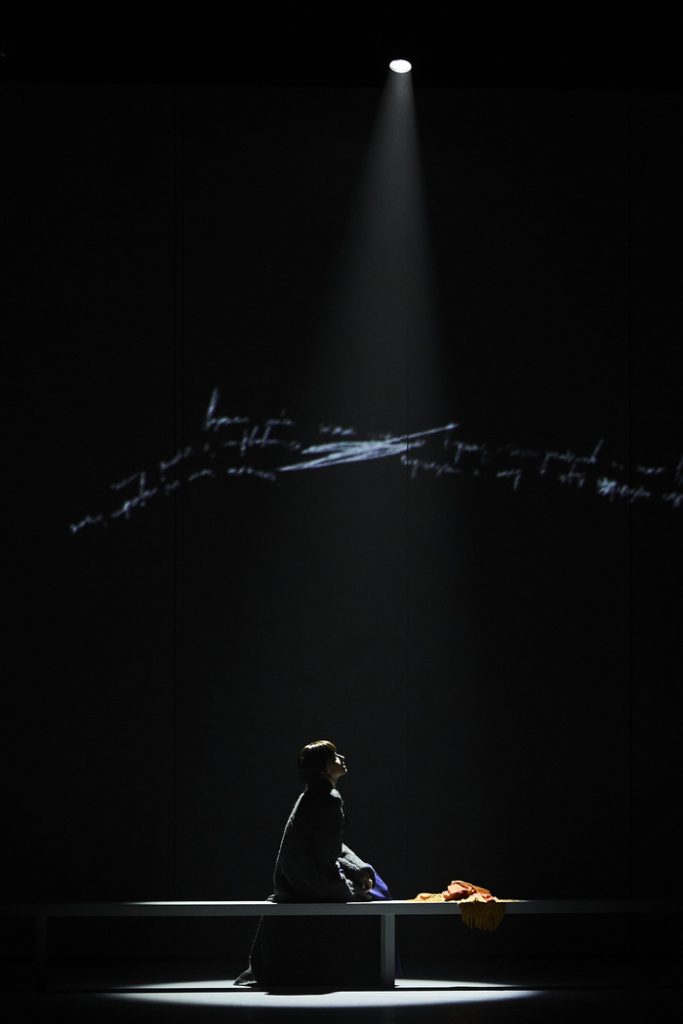
 On one occasion, after Akhmatova had left Modigliani for Gumilev, Modigliani rolled across the floor like a nerve-racked, anguished bundle. In her memories, Akhmatova wrote that “Obviously [Modigliani] began drinking at a later stage, but hashish had already made its appearance in the stories he told.” A “certain madame” (Yaroslavna Kuprina) appeared in his life and exerted a great influence on him. Because of her, Akhmatova lamented that “No letter came for me today.”
On one occasion, after Akhmatova had left Modigliani for Gumilev, Modigliani rolled across the floor like a nerve-racked, anguished bundle. In her memories, Akhmatova wrote that “Obviously [Modigliani] began drinking at a later stage, but hashish had already made its appearance in the stories he told.” A “certain madame” (Yaroslavna Kuprina) appeared in his life and exerted a great influence on him. Because of her, Akhmatova lamented that “No letter came for me today.”
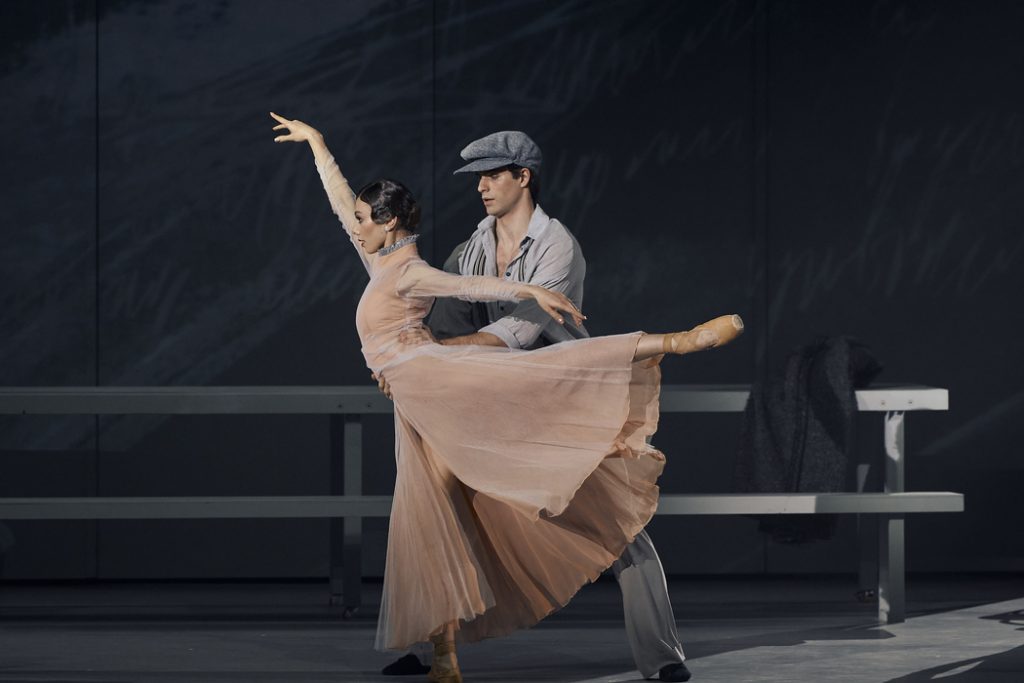 Contrary to her earlier lines (i.e. “The two of us won’t share a glass together”), she did reunite with Modigliani, who seemed eternally grateful but suddenly looked vulnerable. Gumilev must have learned about his wife’s latest departure from the letter he crumpled up. He then lay flat as a pancake on the table and curled up like a lost child.
Contrary to her earlier lines (i.e. “The two of us won’t share a glass together”), she did reunite with Modigliani, who seemed eternally grateful but suddenly looked vulnerable. Gumilev must have learned about his wife’s latest departure from the letter he crumpled up. He then lay flat as a pancake on the table and curled up like a lost child.
As Akhmatova continued to feel torn between two men, Gumilev’s contempt grew. He dumped his wife into Modigliani’s arms, his limbs thrashing in the air. It wasn’t clear whether he was angry about Akhmatova or about having cleared things up. From that moment, the color of Sevenard’s dress was muted.
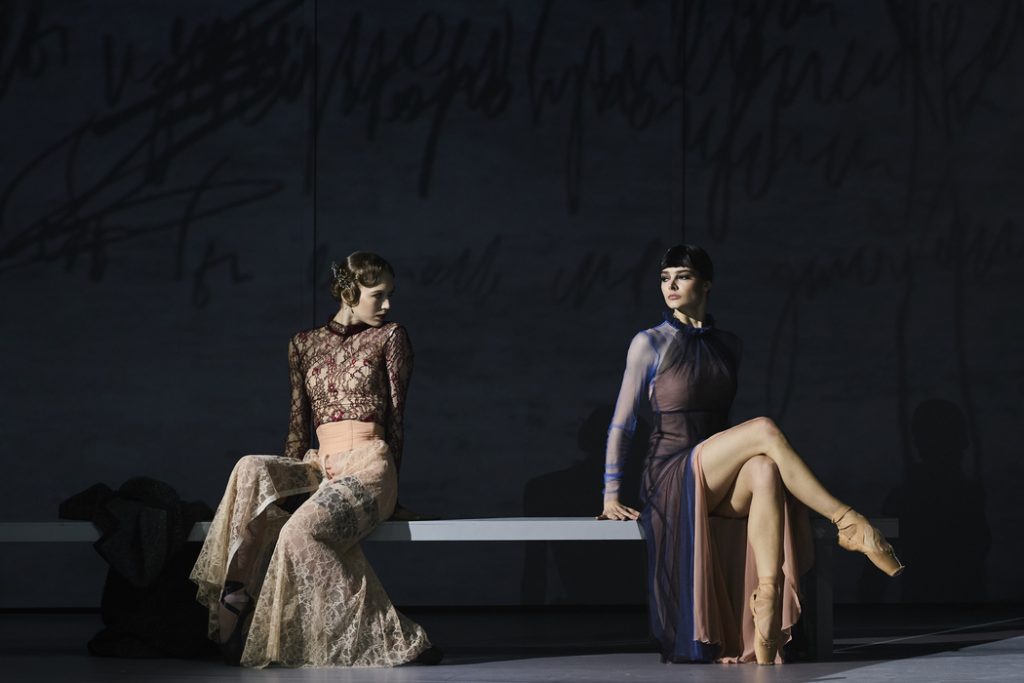
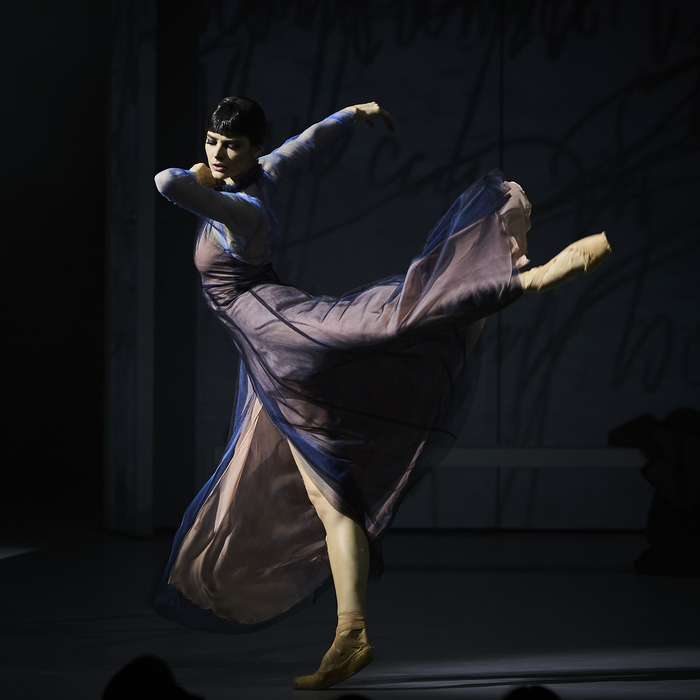 Akhmatova later lost sight of Modigliani. No one knew him, Malikova said, and “Someone described him as a ‘drunken monster’ or something of the sort.” Perhaps the many pages that flew onto the stage from the left wing like fallen leaves in autumn symbolized the end of their romance. Perhaps they testified to Akhmatova’s success as an author.
Akhmatova later lost sight of Modigliani. No one knew him, Malikova said, and “Someone described him as a ‘drunken monster’ or something of the sort.” Perhaps the many pages that flew onto the stage from the left wing like fallen leaves in autumn symbolized the end of their romance. Perhaps they testified to Akhmatova’s success as an author.
The three nameless couples that intermingled with the main protagonists several times knelt in line with them in a final arm 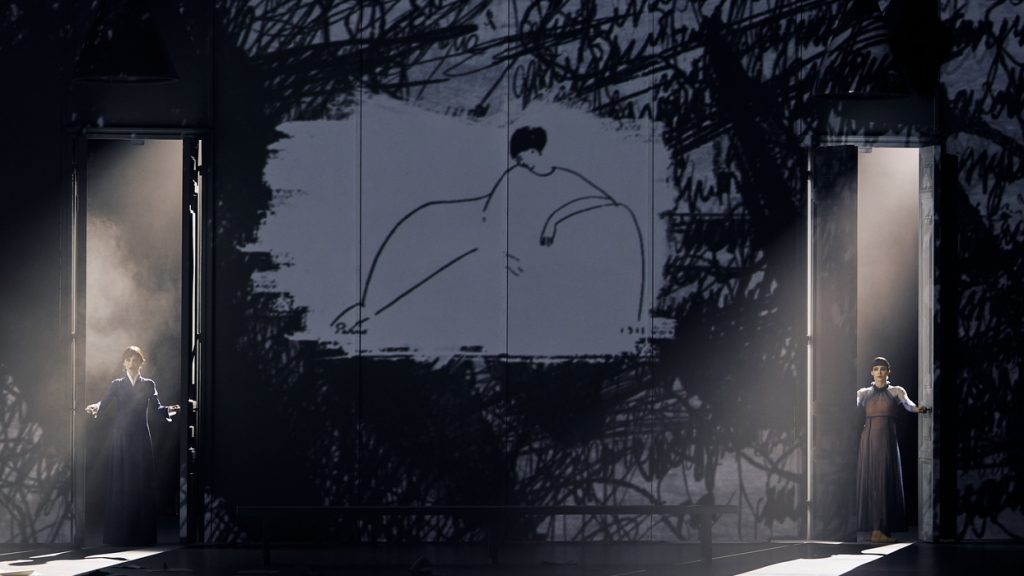 movement routine, the intention of which I failed to grasp. As Malikova and Sevenard each walked toward opposite doors, Modigliani’s 1911 drawing of Akhmatova hung above their heads. The last poem Malikova recited was “Twenty-First. Night. Monday.” It mentioned a secret that reveals itself to some, “And on them silence settles down.” Together with Malikova, this secret vanished behind the slowly closing door.
movement routine, the intention of which I failed to grasp. As Malikova and Sevenard each walked toward opposite doors, Modigliani’s 1911 drawing of Akhmatova hung above their heads. The last poem Malikova recited was “Twenty-First. Night. Monday.” It mentioned a secret that reveals itself to some, “And on them silence settles down.” Together with Malikova, this secret vanished behind the slowly closing door.
Unlike in The Seagull or The Queen of Spades, for example, Possokhov’s choreography lacked intensity and clarity, but was similar to memories gilded by time. The many poems provided a strong framework, especially since Malikova was almost constantly on stage. César Franck’s Piano Quintet in F minor added acoustic depth.
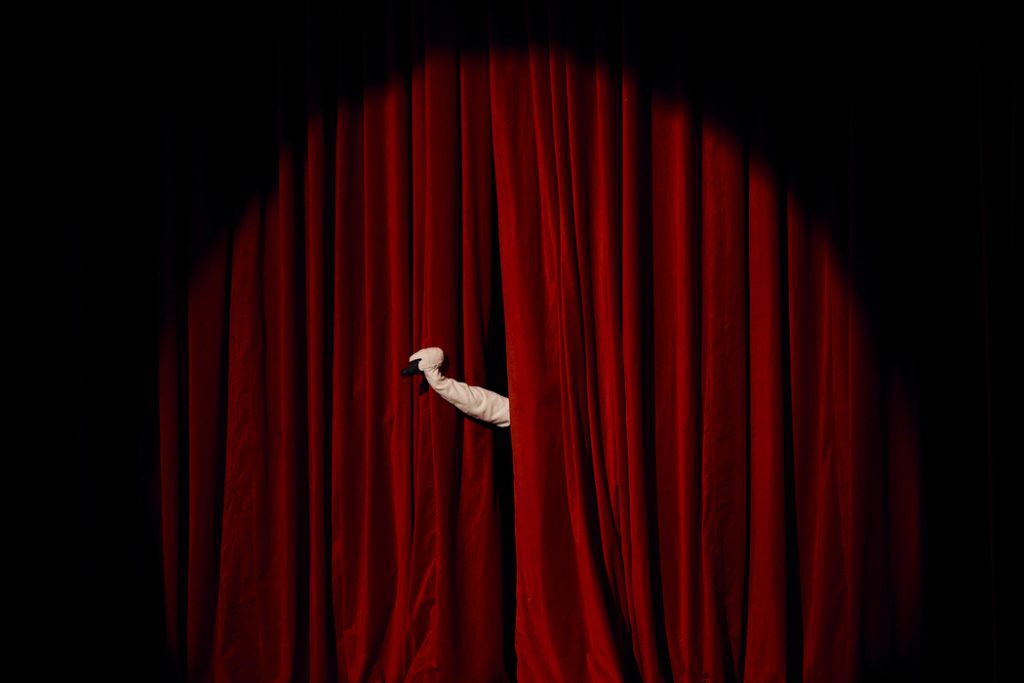 Pavlova opened with a sound by Ignat Krasikov’s clarinet that must have tapped an old underground pipeline. Once surfaced, it developed into a melody that fizzed and warbled like a cheeky bird. Tongue-in-cheek humor immediately filled the air. Lush red drapery and a semicircular spotlight turned the stage into an intimate cabaret. Apparently, one ballerina wasn’t enough to portray an artist as scintillating as Pavlova, so Glukhov employed six. Three of them (Anastasia Stashkevich, Yaroslavna Kuprina, and Elizaveta Kokoreva) performed solos and pas de deux, and the other three joined them in the final scene. Kokoreva in particular danced a great deal (and superbly conveyed Pavlova’s charm and esprit).
Pavlova opened with a sound by Ignat Krasikov’s clarinet that must have tapped an old underground pipeline. Once surfaced, it developed into a melody that fizzed and warbled like a cheeky bird. Tongue-in-cheek humor immediately filled the air. Lush red drapery and a semicircular spotlight turned the stage into an intimate cabaret. Apparently, one ballerina wasn’t enough to portray an artist as scintillating as Pavlova, so Glukhov employed six. Three of them (Anastasia Stashkevich, Yaroslavna Kuprina, and Elizaveta Kokoreva) performed solos and pas de deux, and the other three joined them in the final scene. Kokoreva in particular danced a great deal (and superbly conveyed Pavlova’s charm and esprit).
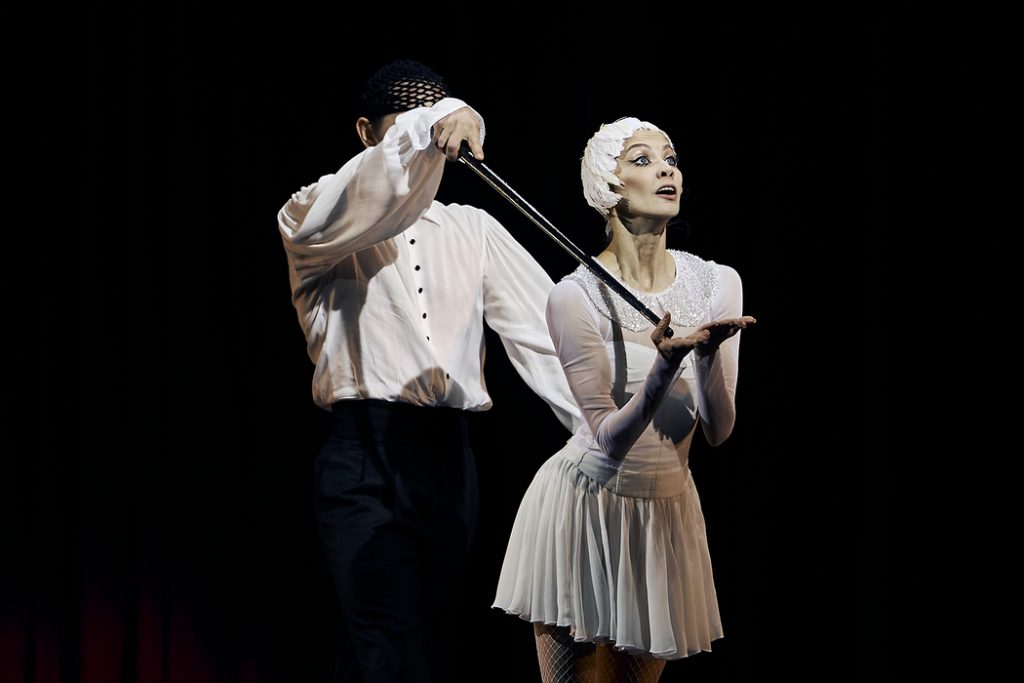
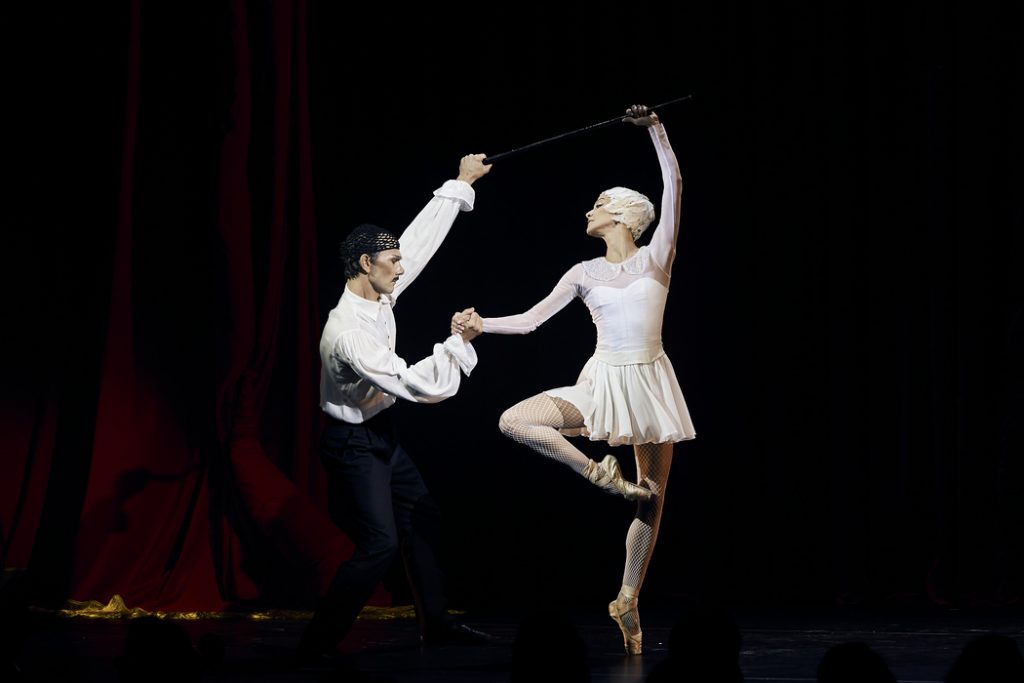 Walking across the stage as if lost, Stashkevich, Kuprina, and Kokoreva curtseyed (either modestly, coquettishly, or with the grandeur of a seasoned artist) and disappeared behind the curtain. Only a plush swan peeped out from behind, but it quickly ducked its head backstage. Cecchetti (Vyacheslav Lopatin), who strode on stage as if he were a caricature of the Legat brothers, lured the swan back, resolutely clutched its neck, and pulled it on stage.
Walking across the stage as if lost, Stashkevich, Kuprina, and Kokoreva curtseyed (either modestly, coquettishly, or with the grandeur of a seasoned artist) and disappeared behind the curtain. Only a plush swan peeped out from behind, but it quickly ducked its head backstage. Cecchetti (Vyacheslav Lopatin), who strode on stage as if he were a caricature of the Legat brothers, lured the swan back, resolutely clutched its neck, and pulled it on stage.
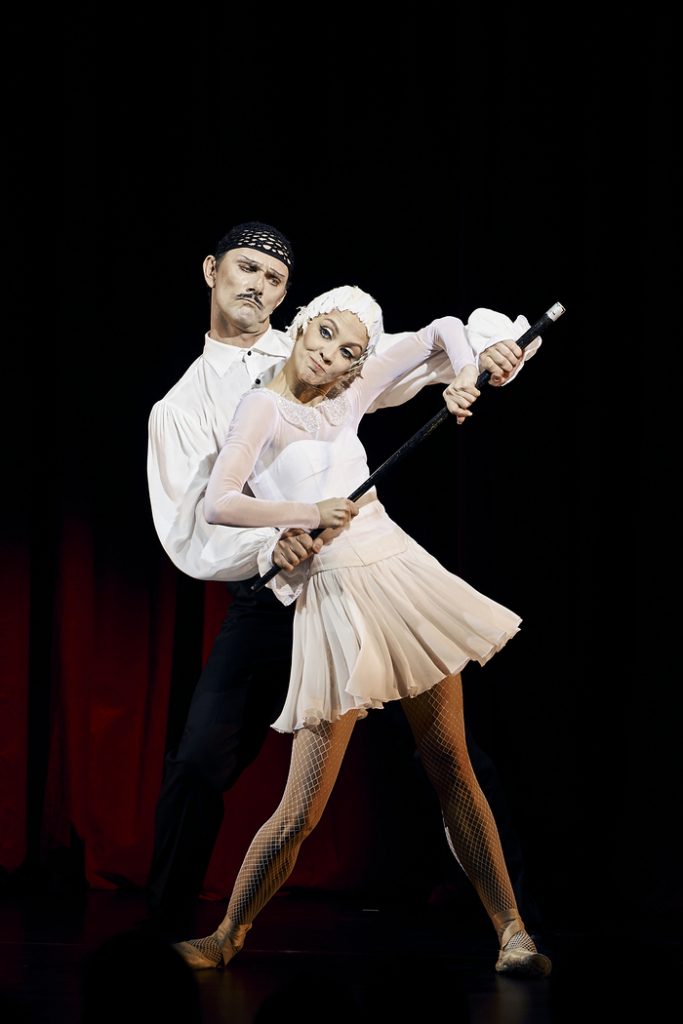
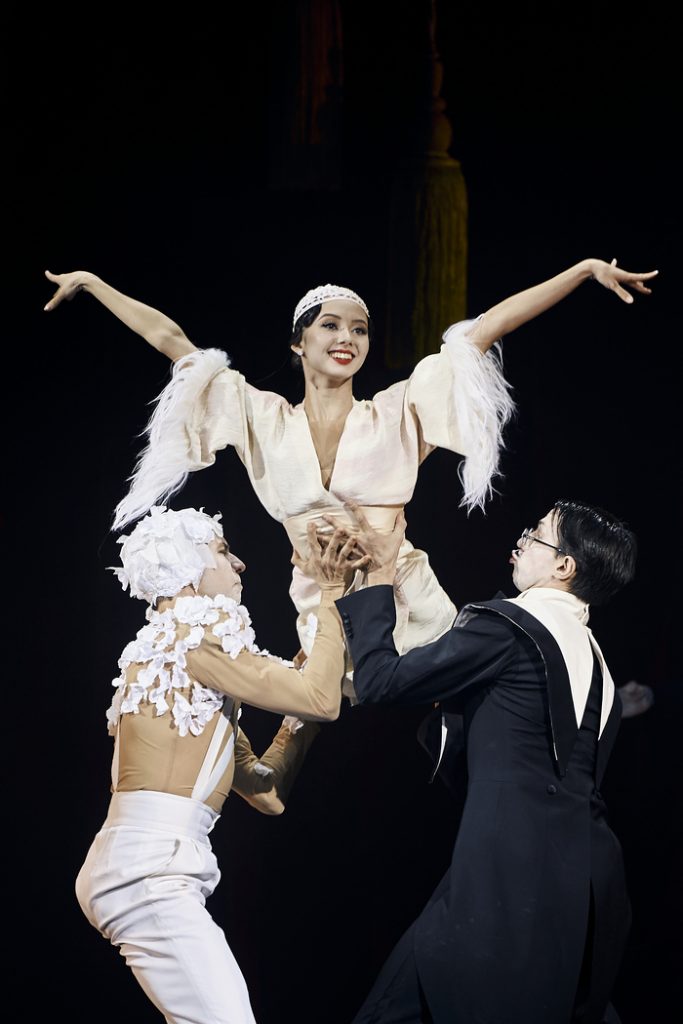
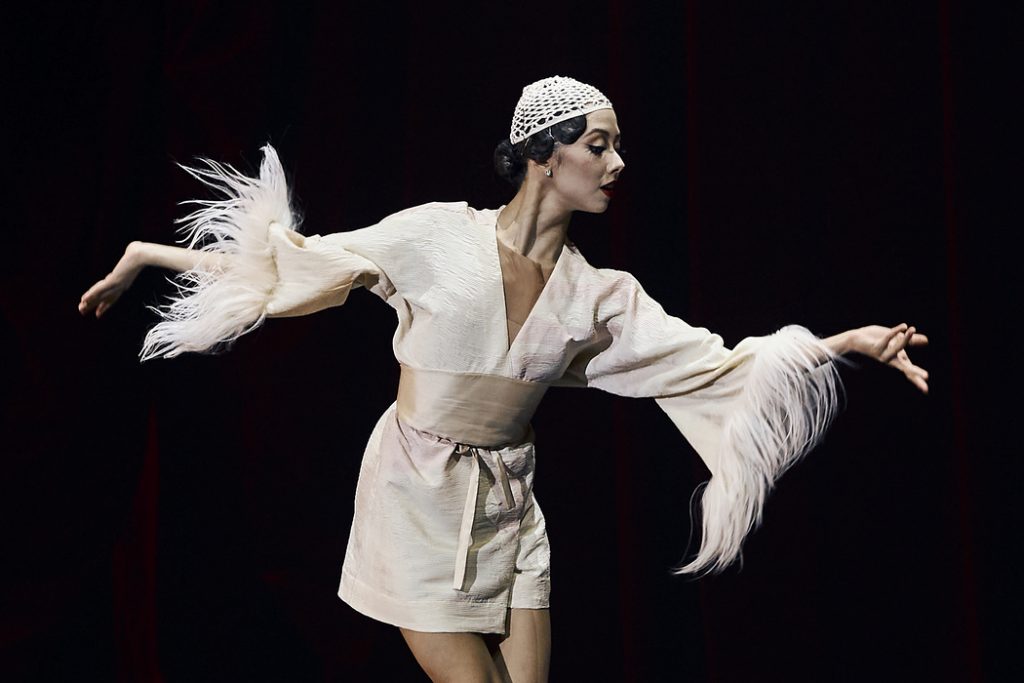 The puppeteer attached to the swan’s neck was Pavlova. Cecchetti’s cane worked like a magic wand on her. Its slap urged her to the barre, where it honed her line. It manipulated Pavlova like a puppet rod, supported and flirted with her, and, once in her hands, turned against its owner.
The puppeteer attached to the swan’s neck was Pavlova. Cecchetti’s cane worked like a magic wand on her. Its slap urged her to the barre, where it honed her line. It manipulated Pavlova like a puppet rod, supported and flirted with her, and, once in her hands, turned against its owner.
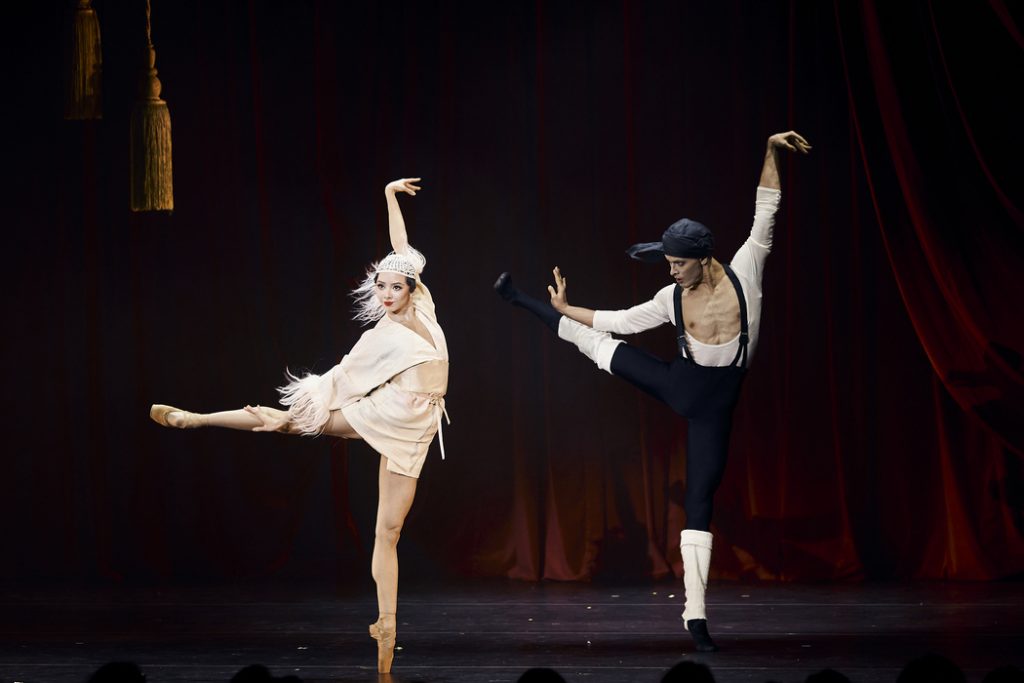
 The white swan feather that floored Michel Fokine (Makar Mikhalkin, who wore striped pants, suspenders, and a white bow tie) inspired him to perform a lightweight, acrobatic solo from which the idea for The Swan emerged. An innovative choreographer, Fokine brimmed over with novelties. How Pavlova absorbed the swan nature was unclear, but her arms undulated perfectly at the end of their rehearsal. She didn’t dance the swan with Mikhail Mordkin (Ildar Gainutdinov), though. He was a straddle-legged muscleman with a pirate-like headscarf who grimaced like a surprised comic figure, and he propelled her around, lifted her like barbells, and twisted and
The white swan feather that floored Michel Fokine (Makar Mikhalkin, who wore striped pants, suspenders, and a white bow tie) inspired him to perform a lightweight, acrobatic solo from which the idea for The Swan emerged. An innovative choreographer, Fokine brimmed over with novelties. How Pavlova absorbed the swan nature was unclear, but her arms undulated perfectly at the end of their rehearsal. She didn’t dance the swan with Mikhail Mordkin (Ildar Gainutdinov), though. He was a straddle-legged muscleman with a pirate-like headscarf who grimaced like a surprised comic figure, and he propelled her around, lifted her like barbells, and twisted and 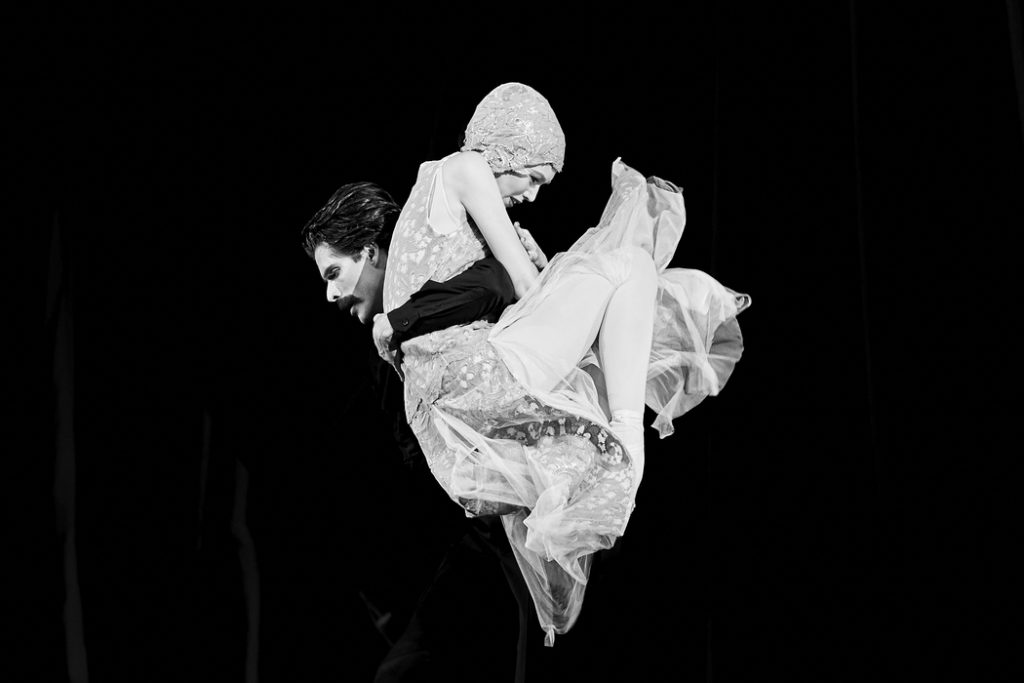 folded her in every direction imaginable. It’s said that Mordkin’s sheer physicality brought out the vamp in Pavlova. Obviously, this was the only way to handle him.
folded her in every direction imaginable. It’s said that Mordkin’s sheer physicality brought out the vamp in Pavlova. Obviously, this was the only way to handle him.
The top-hatted Diaghilev (Mark Orlov), whose overlong arms and hunched posture emulated a gorilla, was busy pacifying the constantly quarreling Nijinsky (Alexei Gainutdinov, who wore a white version of Nijinsky’s Le Spectre de la rose costume) and Stravinsky (Anton Gainutdinov). They chased one another in a boxing fight. In a quiet moment, the first tunes of The Rite of Spring came into Stravinsky’s mind, and once written down, he handed them to Korobeinikov in the orchestra pit. Tied up in knots and terribly punctilious, Stravinsky turned ecstatic while listening to Korobeinikov hammering the staccato rhythm.
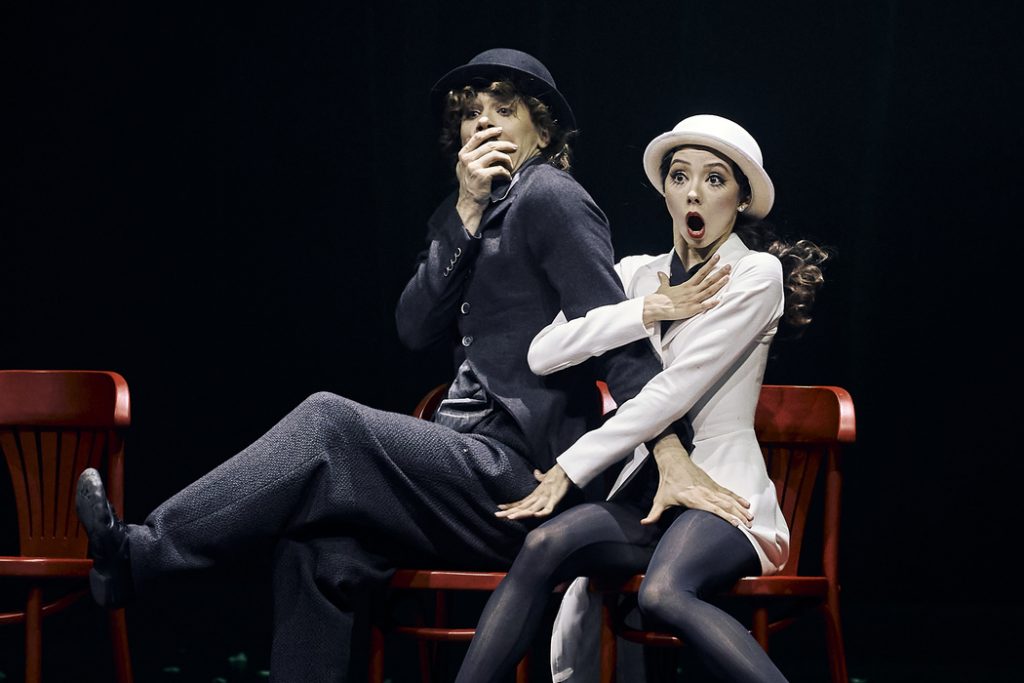
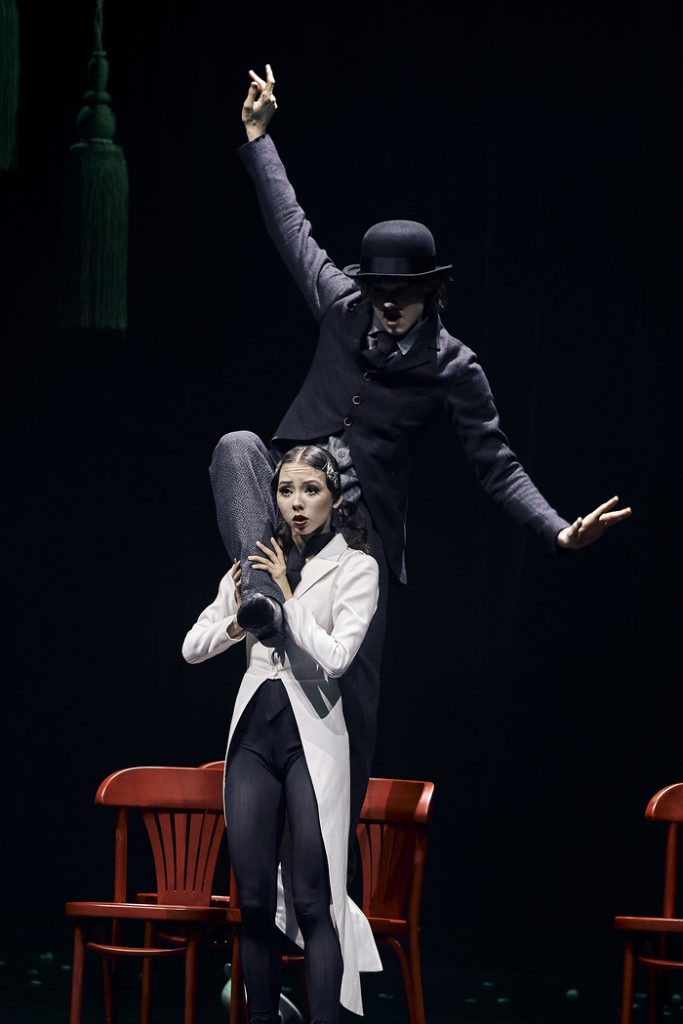
 Of all the men, Victor Dandré (Mark Orlov), Pavlova’s husband, was the least eccentric, and their wedding pas de deux was calm and poetic. Irresistible sweet, by comparison, was the sight of Kokoreva’s Pavlova next to Alexei Putintsev’s Charlie Chaplin. In real life, Pavlova and Chaplin met at his Hollywood Studio in Los Angeles. A photograph shows them sitting hand in hand on a bench. On stage, Pavlova and Chaplin sat on red chairs playing a “going-to-Jerusalem”-esque game, although there was no shortage of chairs. Spellbound by a film we couldn’t see, they constantly pushed, nudged, climbed across, and accidentally groped one another. A black-and-white clip of Chaplin’s waddling gait, followed by a steam engine that sped toward Pavlova, added a grave overtone.
Of all the men, Victor Dandré (Mark Orlov), Pavlova’s husband, was the least eccentric, and their wedding pas de deux was calm and poetic. Irresistible sweet, by comparison, was the sight of Kokoreva’s Pavlova next to Alexei Putintsev’s Charlie Chaplin. In real life, Pavlova and Chaplin met at his Hollywood Studio in Los Angeles. A photograph shows them sitting hand in hand on a bench. On stage, Pavlova and Chaplin sat on red chairs playing a “going-to-Jerusalem”-esque game, although there was no shortage of chairs. Spellbound by a film we couldn’t see, they constantly pushed, nudged, climbed across, and accidentally groped one another. A black-and-white clip of Chaplin’s waddling gait, followed by a steam engine that sped toward Pavlova, added a grave overtone.

 Warmth, trust, and playfulness characterized Pavlova’s friendship with Alexander Vertinsky (Vyacheslav Lopatin). Sitting together, they reminded me of an ageing couple recalling the good old days. Vertinsky stayed back while Pavlova traveled the world (a huge elephant represented her trip to India). As he sat in the semi-darkness wearing a white ruff and a narrow, black cap, he looked like the melancholic Pierrot of his own stage career.
Warmth, trust, and playfulness characterized Pavlova’s friendship with Alexander Vertinsky (Vyacheslav Lopatin). Sitting together, they reminded me of an ageing couple recalling the good old days. Vertinsky stayed back while Pavlova traveled the world (a huge elephant represented her trip to India). As he sat in the semi-darkness wearing a white ruff and a narrow, black cap, he looked like the melancholic Pierrot of his own stage career.

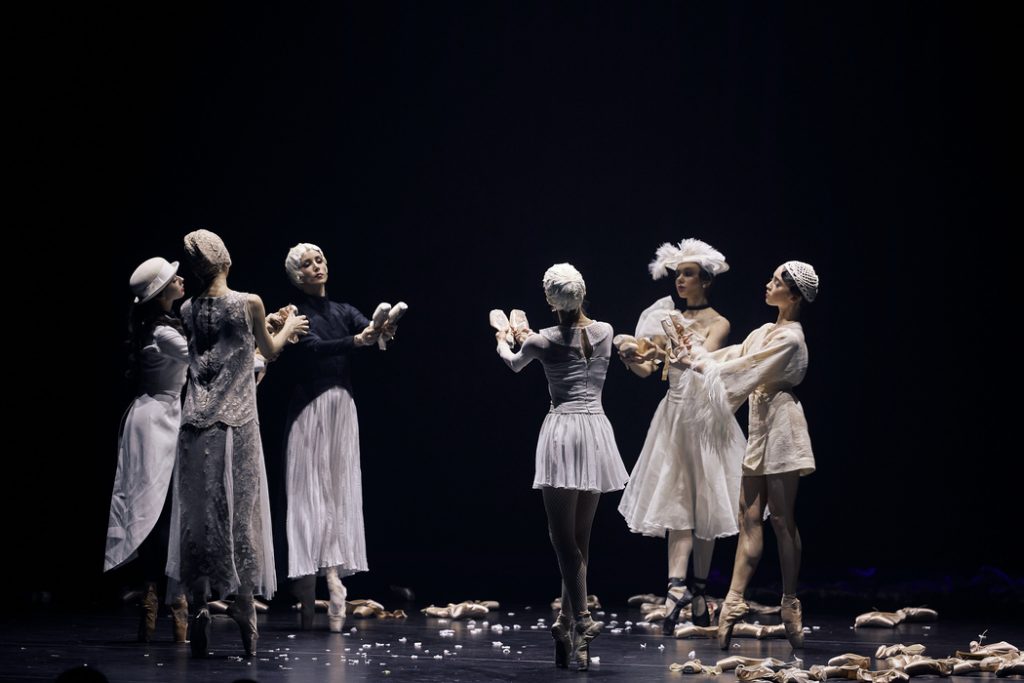 Countless numbers of pointe shoes were scattered on stage when all six Pavlovas joined for their final swan dance. Dissonant piano chords accompanied them as they bouréed in line toward a spotlight. Against the blazing light, their undulating arms seemed to belong to a single body. For a moment, they looked like Shiva surrounded by a bright aura. A spotlight that searched the stage afterward lit nothing but used pointe shoes.
Countless numbers of pointe shoes were scattered on stage when all six Pavlovas joined for their final swan dance. Dissonant piano chords accompanied them as they bouréed in line toward a spotlight. Against the blazing light, their undulating arms seemed to belong to a single body. For a moment, they looked like Shiva surrounded by a bright aura. A spotlight that searched the stage afterward lit nothing but used pointe shoes.
| Link: | Diaghilev P.S. International Festival of Arts | |
| Photos: | 1. | Polina Malikova (Anna Akhmatova), Eleonora Sevenard (Anna Akhmatova), and Daniil Potaptsev (Nikolai Gumilev), “Akhmatova” by Yuri Possokhov, MuzArts 2025 |
| 2. | Polina Malikova (Anna Akhmatova) and Eleonora Sevenard (Anna Akhmatova), “Akhmatova” by Yuri Possokhov, MuzArts 2025 |
|
| 3. | Daniil Potaptsev (Nikolai Gumilev) and ensemble, “Akhmatova” by Yuri Possokhov, MuzArts 2025 |
|
| 4. | Eleonora Sevenard (Anna Akhmatova), “Akhmatova” by Yuri Possokhov, MuzArts 2025 | |
| 5. | Eleonora Sevenard (Anna Akhmatova), Alexei Putintsev (Amedeo Modigliani), Polina Malikova (Anna Akhmatova), and ensemble; “Akhmatova” by Yuri Possokhov, MuzArts 2025 | |
| 6. | Eleonora Sevenard (Anna Akhmatova), “Akhmatova” by Yuri Possokhov, MuzArts 2025 | |
| 7. | Alexei Putintsev (Amedeo Modigliani), Eleonora Sevenard (Anna Akhmatova), Daniil Potaptsev (Nikolai Gumilev), and ensemble; “Akhmatova” by Yuri Possokhov, MuzArts 2025 | |
| 8. | Alexei Putintsev (Amedeo Modigliani), “Akhmatova” by Yuri Possokhov, MuzArts 2025 | |
| 9. | Eleonora Sevenard (Anna Akhmatova), “Akhmatova” by Yuri Possokhov, MuzArts 2025 | |
| 10. | Polina Malikova (Anna Akhmatova), “Akhmatova” by Yuri Possokhov, MuzArts 2025 | |
| 11. | Alexei Putintsev (Amedeo Modigliani) and Eleonora Sevenard (Anna Akhmatova), “Akhmatova” by Yuri Possokhov, MuzArts 2025 | |
| 12. | Ensemble, “Akhmatova” by Yuri Possokhov, MuzArts 2025 | |
| 13. | Yaroslavna Kuprina (Jeanne) and Eleonora Sevenard (Anna Akhmatova), “Akhmatova” by Yuri Possokhov, MuzArts 2025 | |
| 14. | Eleonora Sevenard (Anna Akhmatova), “Akhmatova” by Yuri Possokhov, MuzArts 2025 | |
| 15. | Polina Malikova (Anna Akhmatova) and Eleonora Sevenard (Anna Akhmatova), “Akhmatova” by Yuri Possokhov, MuzArts 2025 | |
| 16. | Scene from “Pavlova” by Pavel Glukhov, MuzArts 2025 |
|
| 17. | Vyacheslav Lopatin (Cecchetti) and Anastasia Stashkevich (Anna Pavlova), “Pavlova” by Pavel Glukhov, MuzArts 2025 |
|
| 18. | Vyacheslav Lopatin (Cecchetti) and Anastasia Stashkevich (Anna Pavlova), “Pavlova” by Pavel Glukhov, MuzArts 2025 | |
| 19. | Vyacheslav Lopatin (Enrico Cecchetti) and Anastasia Stashkevich (Anna Pavlova), “Pavlova” by Pavel Glukhov, MuzArts 2025 | |
| 20. | Alexei Gainutdinov (Vaslav Nijinsky), Elizaveta Kokoreva (Anna Pavlova), and Anton Gainutdinov (Igor Stravinsky); “Pavlova” by Pavel Glukhov, MuzArts 2025 | |
| 21. | Elizaveta Kokoreva (Anna Pavlova), “Pavlova” by Pavel Glukhov, MuzArts 2025 | |
| 22. | Elizaveta Kokoreva (Anna Pavlova), “Pavlova” by Pavel Glukhov, MuzArts 2025 | |
| 23. | Elizaveta Kokoreva (Anna Pavlova) and Ildar Gainutdinov (Mikhail Mordkin), “Pavlova” by Pavel Glukhov, MuzArts 2025 | |
| 24. | Marc Orlov (Victor Dandré) and Yaroslavna Kuprina (Anna Pavlova), “Pavlova” by Pavel Glukhov, MuzArts 2025 | |
| 25. | Marc Orlov (Victor Dandré) and Yaroslavna Kuprina (Anna Pavlova), “Pavlova” by Pavel Glukhov, MuzArts 2025 | |
| 26. | Elizaveta Kokoreva (Anna Pavlova) and Alexei Putintsev (Charlie Chaplin), “Pavlova” by Pavel Glukhov, MuzArts 2025 | |
| 27. | Alexei Putintsev (Charlie Chaplin) and Elizaveta Kokoreva (Anna Pavlova), “Pavlova” by Pavel Glukhov, MuzArts 2025 | |
| 28. | Anastasia Stashkevich (Anna Pavlova) and Vyacheslav Lopatin (Alexander Vertinsky), “Pavlova” by Pavel Glukhov, MuzArts 2025 | |
| 29. | Anastasia Stashkevich (Anna Pavlova) and Vyacheslav Lopatin (Alexander Vertinsky), “Pavlova” by Pavel Glukhov, MuzArts 2025 | |
| 30. | Ensemble, “Pavlova” by Pavel Glukhov, MuzArts 2025 | |
| 31. | Ensemble, “Pavlova” by Pavel Glukhov, MuzArts 2025 | |
| all photos © Diaghilev P.S. Festival/Mikhail Vilchuk | ||
| Editing: | Kayla Kauffman |
